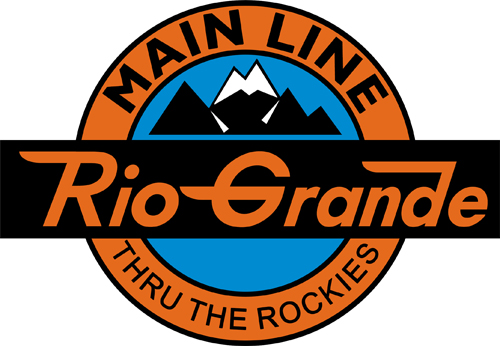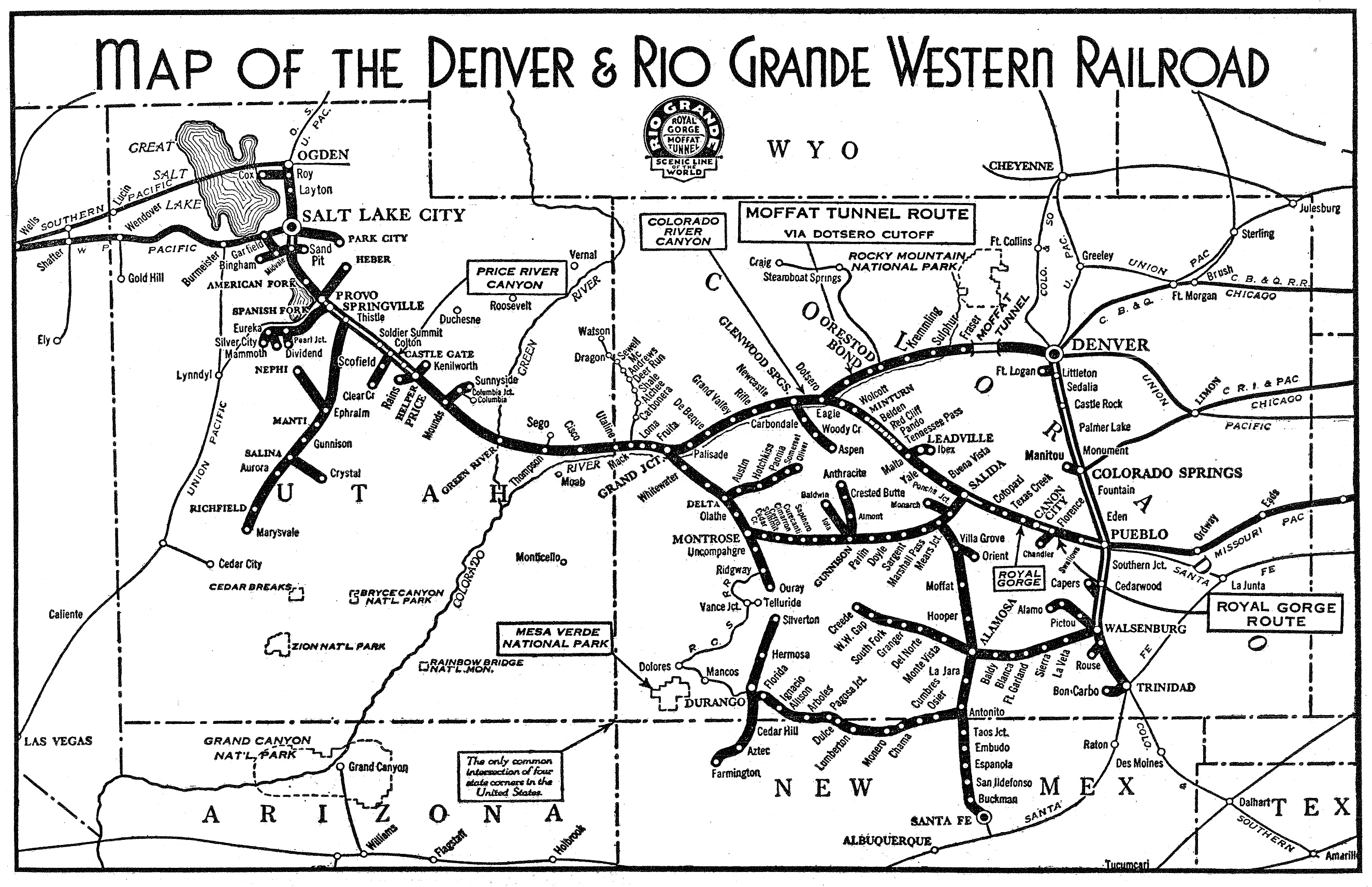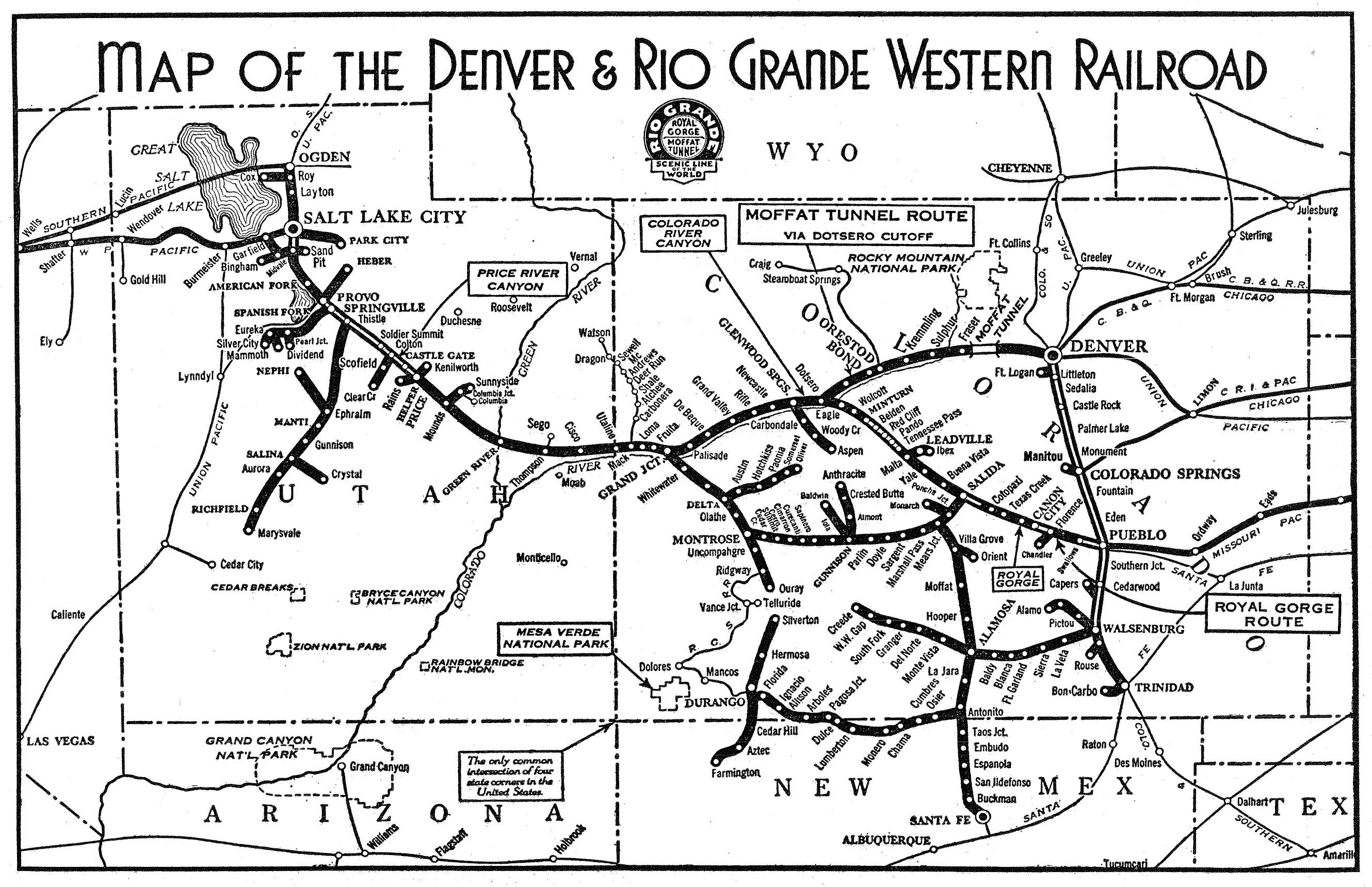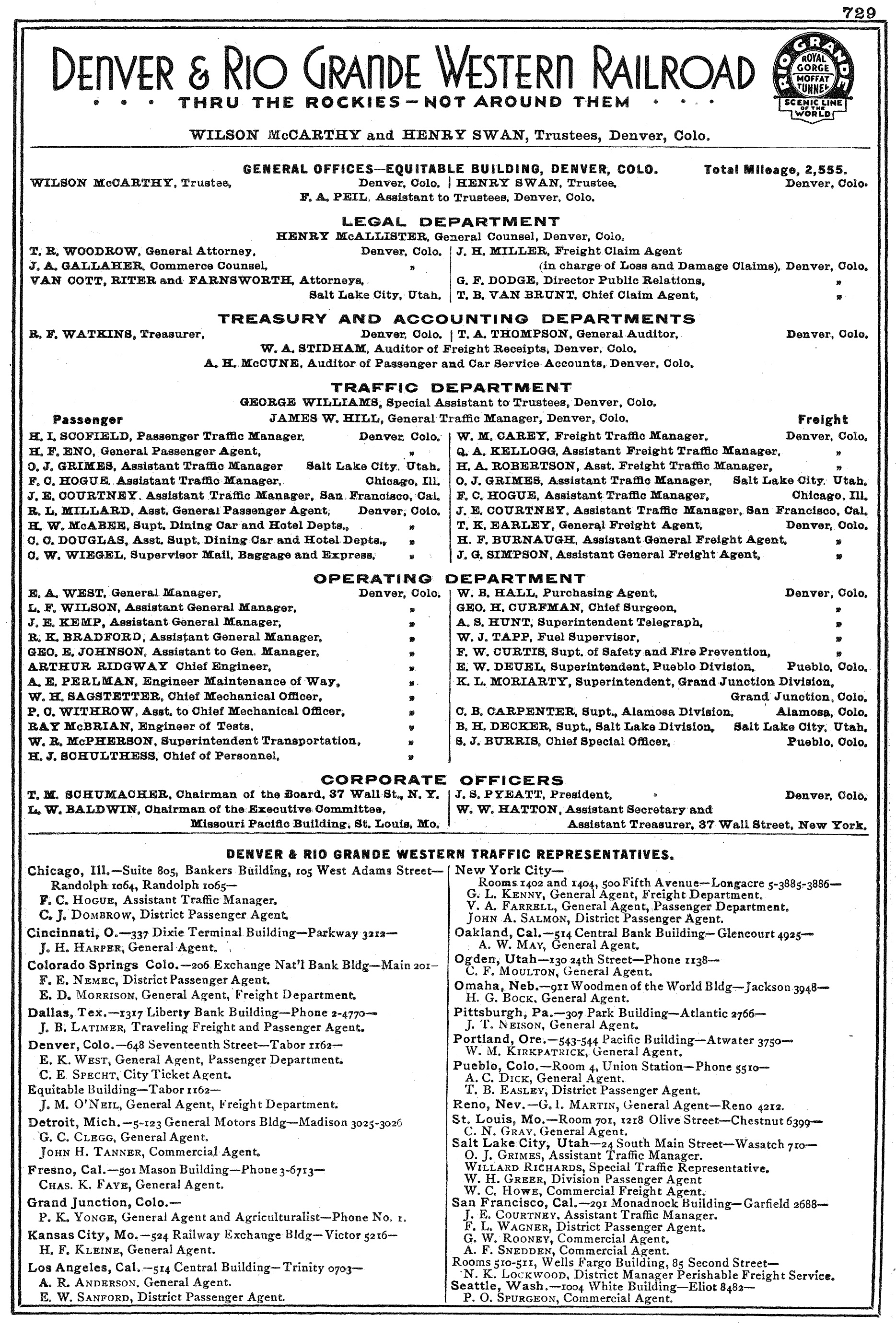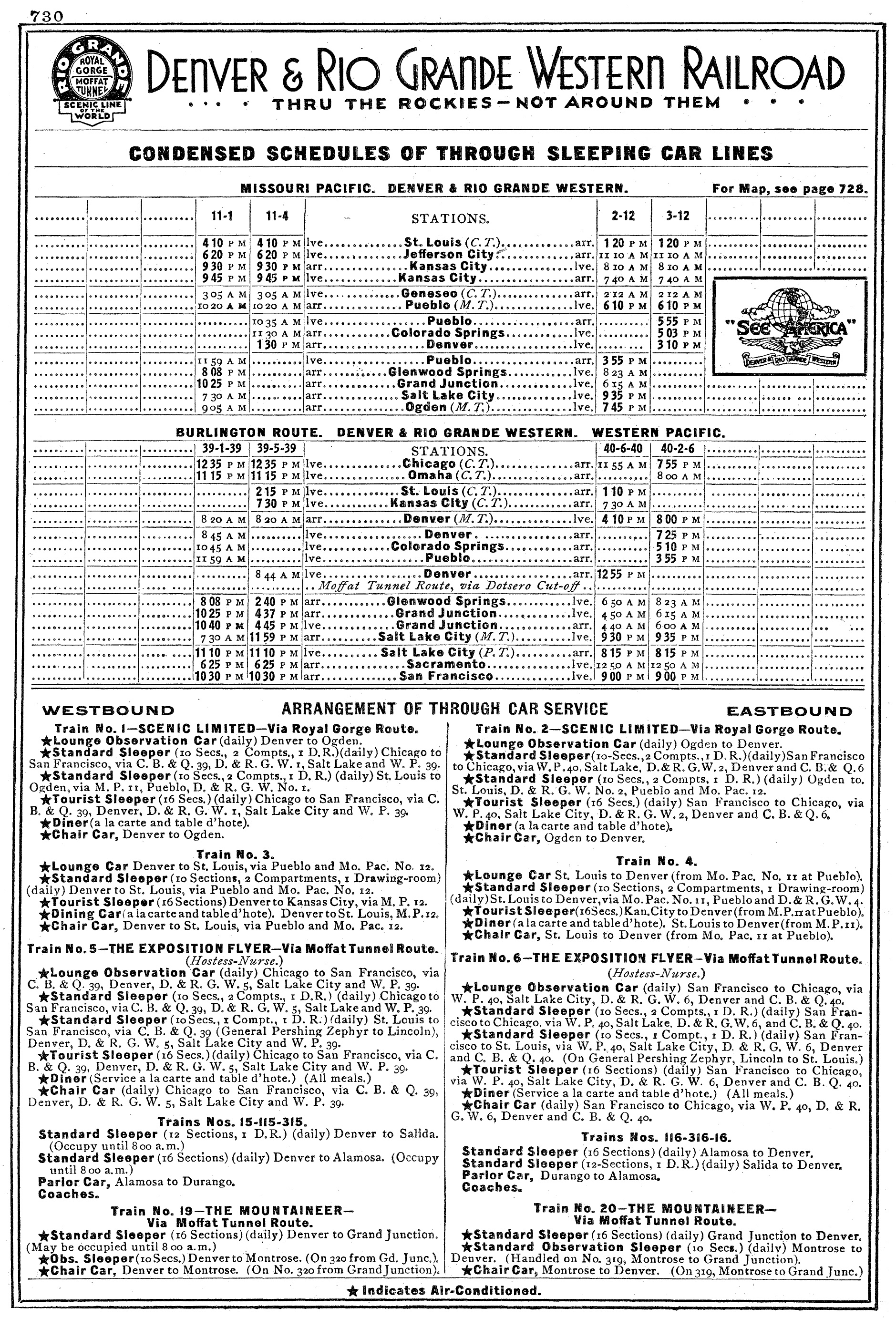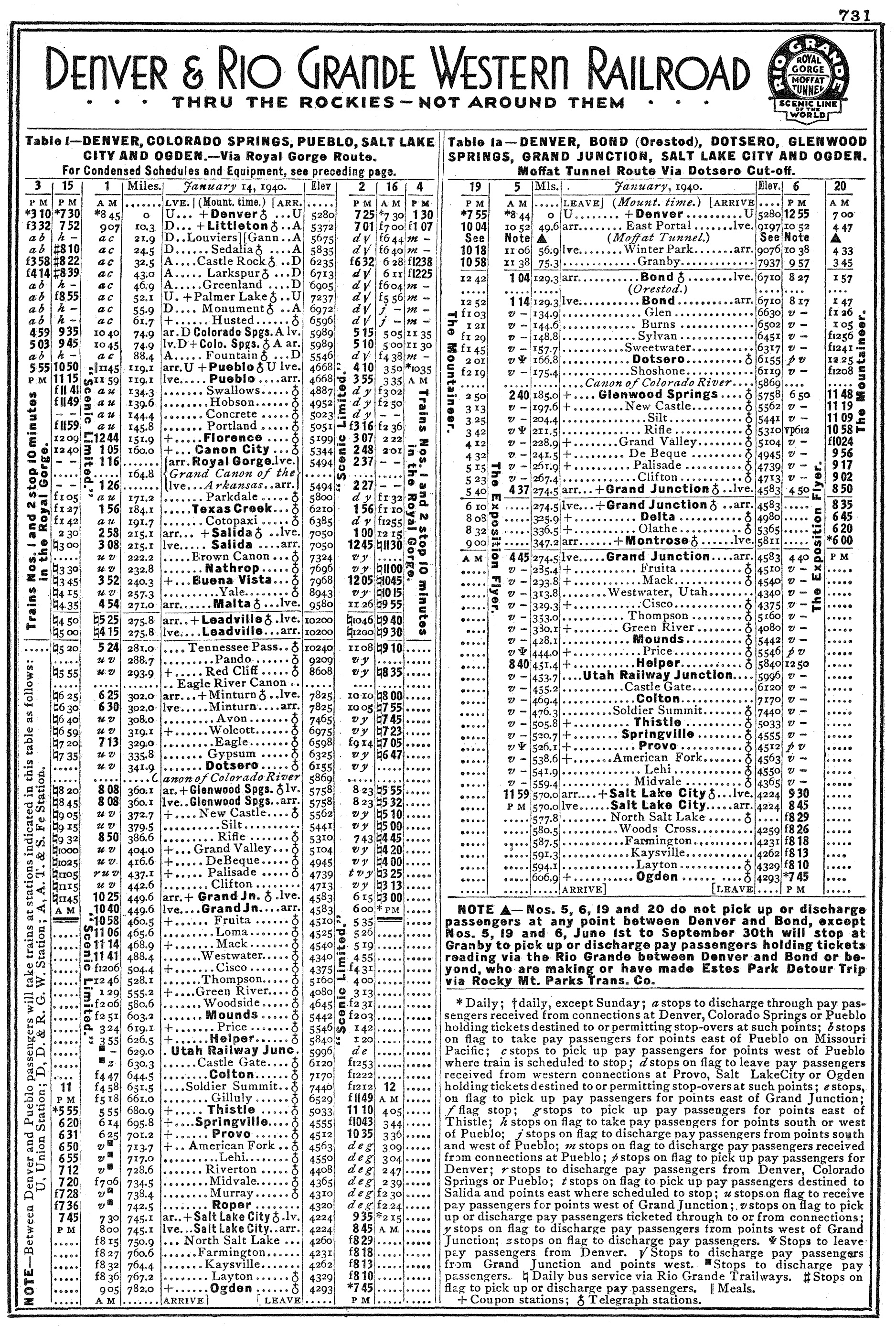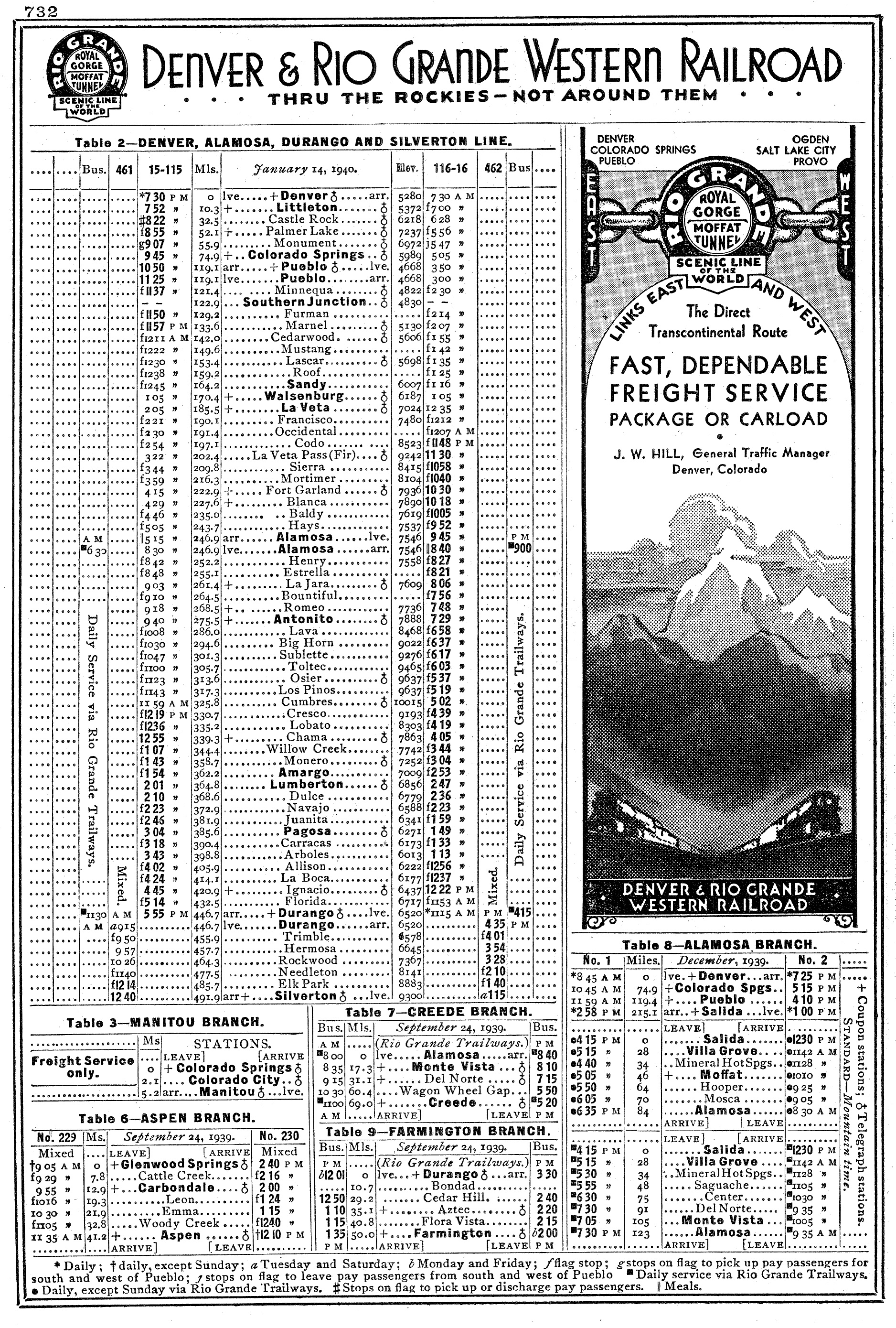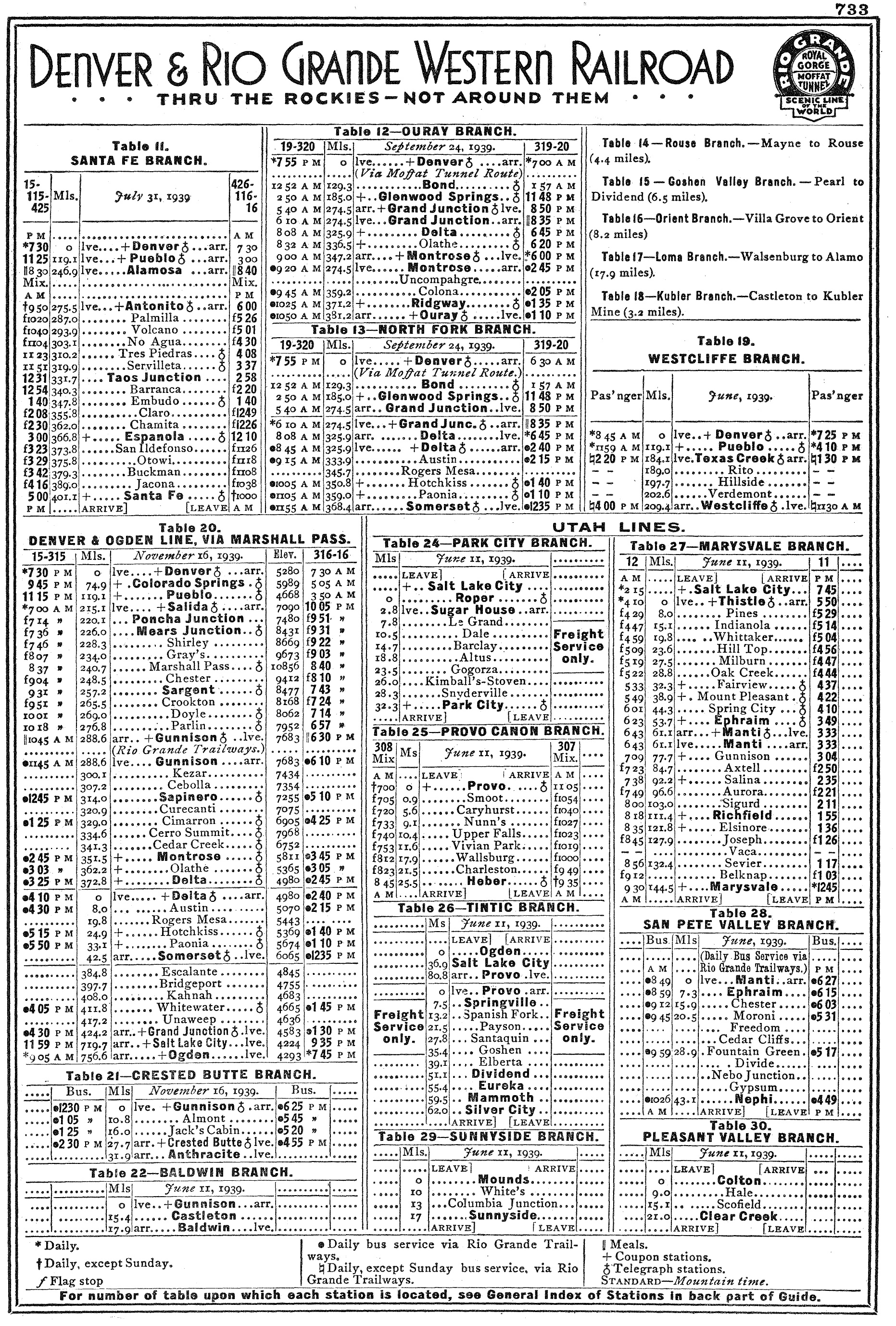Rio Grande Railroad: Map, Logo, History, Rosters
Last revised: November 5, 2024
By: Adam Burns
Perhaps no other major American railroad enjoyed such a colorful and captivating history like the Denver & Rio Grande Western. It was the idea of General William J. Palmer, a decorated U.S. Army officer of the Civil War, who envisioned something which had never before been attempted; a corridor piercing the heart of the Rocky Mountains.
It would link Denver with the Mexican border (following its namesake Rio Grande River for much of the way), reach the San Juan mining district, and head west to Salt Lake City.
As a means of reducing costs, Palmer pioneered the 3-foot, narrow-gauge concept. It became a highly popular, it not sustainable, alternative to standard-gauge rights-of-way during the late 19th century.
History
Ultimately, he failed to reach Mexico but is credited with opening the largest and most successful narrow-gauge network in the United States.
In time, 3-footers proved impractical for interchange and as Rio Grande officials would later realize, its gateway through the Rockies was its most valued asset.
After escaping Gould control the D&RGW enjoyed much success, particularly following the World War II era. In 1988, parent company Rio Grande Industries purchased Southern Pacific and retained the more prominent railroad's name.
Photos
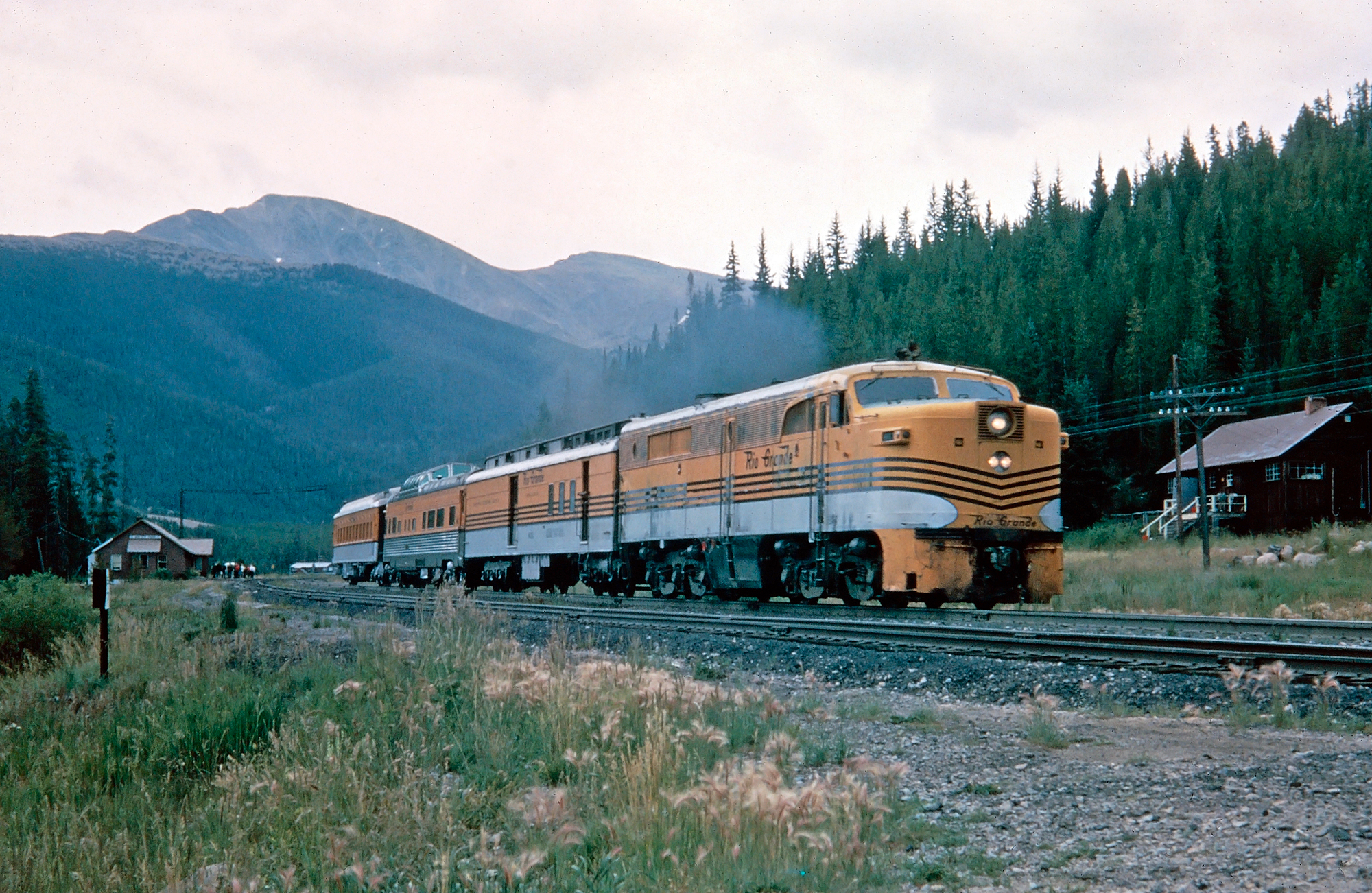 Rio Grande PA-1 #6003 with the westbound "Yampa Valley" at Winter Park, Colorado, circa 1965. American-Rails.com collection.
Rio Grande PA-1 #6003 with the westbound "Yampa Valley" at Winter Park, Colorado, circa 1965. American-Rails.com collection.General William Palmer
As historian Dr. George Hilton notes in his book, "American Narrow Gauge Railroads," despite losing control of New Mexico's Raton Pass, William Palmer did end up creating much of the railroad he had originally visualized.
His interest in the iron horse began early in life when, at the age of 17, he began working for Hempfield Railroad's engineering division.
This system, later acquired by the Baltimore & Ohio, was chartered on May 15, 1850 to link then-Wheeling, Virginia with Greensburg, Pennsylvania. After serving with distinction during the Civil War he hired on with the Kansas Pacific.
According to James Griffin's book, "Rio Grande Railroad," while helping survey this route into Denver, Palmer became convinced Colorado was tailor-made for a railroad; its eastern plains were highly conducive to agricultural development and the Rocky Mountains were rich in precious metals and coal.
Denver & Rio Grande Railway
After the KP's completion in 1870 he left the company, gathered a few business partners from Denver, and chartered the Denver & Rio Grande Railway on October 27th that year Because of the region's rugged topography they decided upon a narrower, 3-foot gauge right-of-way in an effort to reduce costs and avoid clearance issues.
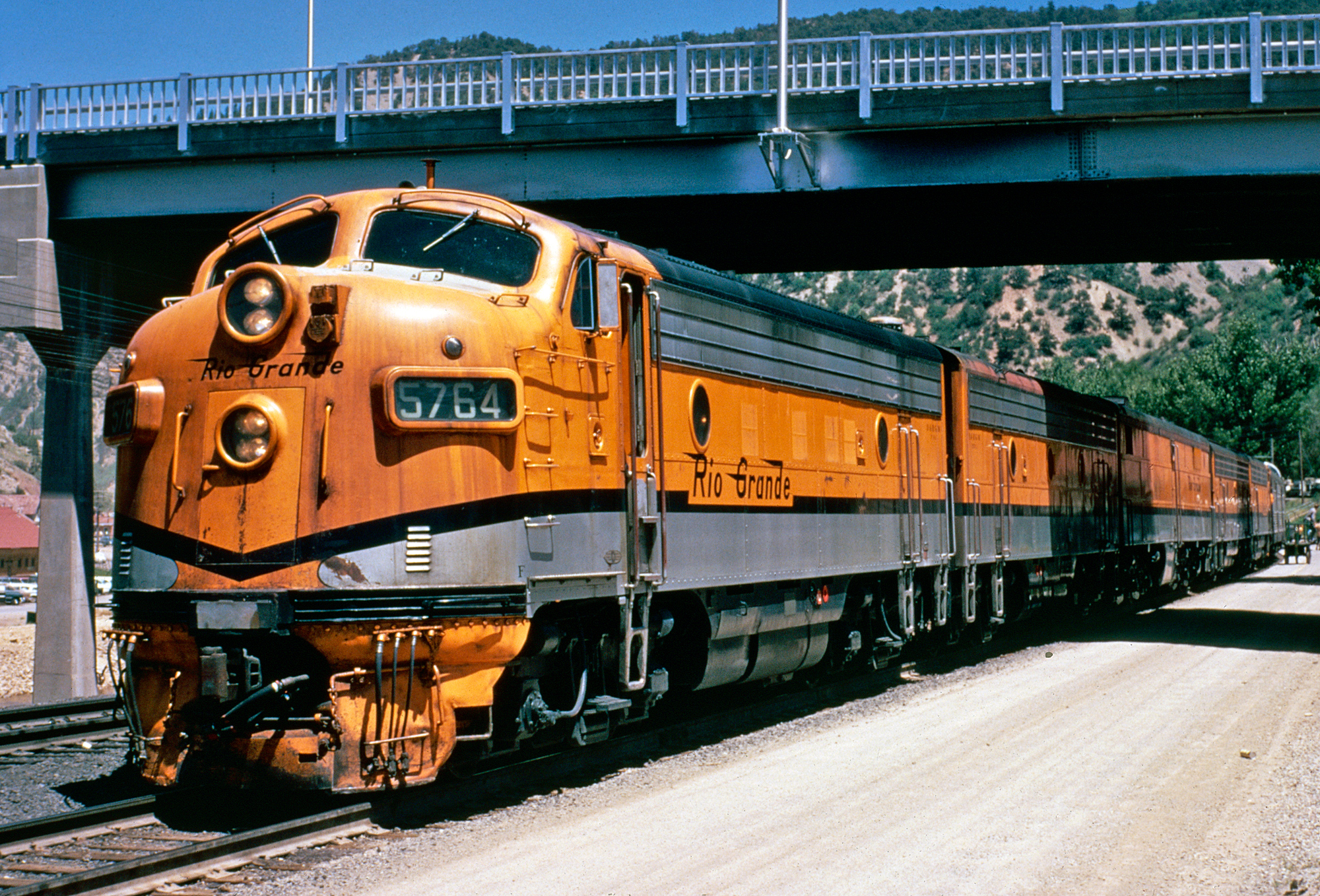 Rio Grande F7A #5764 is stopped in Glenwood Springs, Colorado with train #17, the westbound "Rio Grande Zephyr," during the 1970s. Robert Eastwood, Jr. photo. American-Rails.com collection.
Rio Grande F7A #5764 is stopped in Glenwood Springs, Colorado with train #17, the westbound "Rio Grande Zephyr," during the 1970s. Robert Eastwood, Jr. photo. American-Rails.com collection.They probably did not realize it then but D&RG's promoters spearheaded America's second-most popular gauge. A rail-width of less than 4 feet, 8 1/2 inches had been pioneered in Britain where Isaac W. Boulton of Ashton-under-Lymre built a locomotive capable of utilizing a 2-foot right-of-way in 1861.
Afterwards, talks of a smaller gauge sprang up across the United States although it was the D&RG to first implement it on a wide scale. The Rio Grande's success led to an entire new industry during the 1880's. Curiously, as quickly as these railroads appeared they vanished just as rapidly.
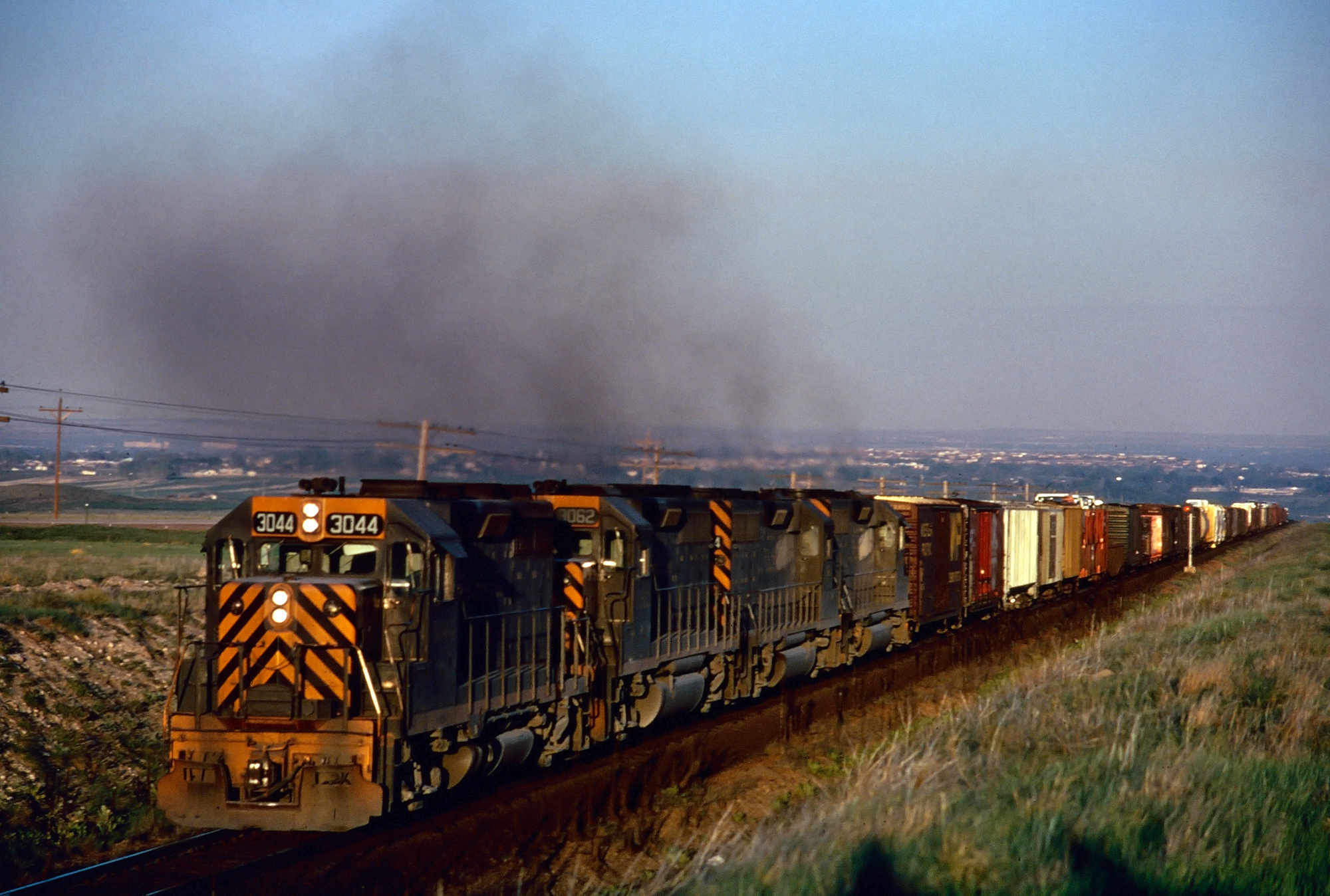 A quartet of Rio Grande Geeps, led by GP35 #3044, make the climb out of Denver with a westbound freight, circa 1967. American-Rails.com collection.
A quartet of Rio Grande Geeps, led by GP35 #3044, make the climb out of Denver with a westbound freight, circa 1967. American-Rails.com collection.Most were either abandoned or converted by the World War I era. Two years after the Rio Grande's chartering a committee was formed to study the narrow-gauge concept; known as the National Railway-Gauge Railway Convention the conference was held in St. Louis during June 19-20, 1872.
Logo
Among the key points discussed was the belief that a three-foot corridor, operating in mountainous environments, could be constructed for one-fifth the cost of major trunk lines like the Baltimore & Ohio, New York Central, and Illinois Central. In addition, across rolling topography, where many railroads were found, cost savings would be about half that of standard.
Construction
For Palmer, his use of the gauge came purely from an economic and practical standpoint. He sought a three-pronged approach:
- The primary route would link Denver with El Paso, Texas running along the Front Range in an effort to establish through service into Mexico.
- A secondary main line would reach the Central Pacific at Salt Lake City/Ogden.
- Finally branches would infiltrate northwestern New Mexico/southwestern Colorado to serve the San Juan Mountains' booming mining industry. Construction of the main line began out of Denver on July 28, 1871.
It took just months to reach the first target, Colorado Springs, with service officially launched to that point on January 1, 1872. Later that year rails were extended to Pueblo while a branch also opened near Cañon City which served local coal mines.
At A Glance
2,443 Miles (1948) 2,413 (1950) 2,238 (1995) | |
3 Feet (1872-1968) 4 Feet, 8 ½ Inches (1888-1988) | |
Denver - Bond, Colorado - Salt Lake City Denver - Pueblo - Dotsero, Colorado Pueblo - Trinidad, Colorado Walsenburg - Alamosa, Colorado Alamos - Durango, Colorado Salida - Gunnison, Colorado Mears Junction-Alamosa Alamosa - Creede, Colorado Bond - Craig, Colorado Grand Junction - Ouray, Colorado Thistle - Marysvale, Utah Salt Lake City - Ogden | |
Steam: 22 (Narrow-Gauge) Diesel: 257 | |
Freight Cars: 12,610 Passenger Cars: 96 | |
Palmer's hesitation to serve this town directly, citing (but not stating) lack of financing, proved a strategic blunder as upset residents, unaware of the monetary issues, sided with the Santa Fe when it tried to reach the Leadville mining district.
While the Rio Grande is historically remembered for serving Colorado's legendary silver industry, black diamonds proved a much steadier traffic source that served the railroad well throughout its corporate history.
Expansion
Unfortunately, before Palmer could establish a steady flow of business the financial Panic of 1873 hit. The D&RG never entered bankruptcy but construction was delayed until the economy improved.
Work finally resumed in 1876 as crews marched southward, reaching coal mines in the Trinidad/El Moro area (near the New Mexico border) a year later.
At the same time, Palmer pressed his railroad westward from Walsenburg, crossed 9,220-foot Veta Pass, and arrived in Alamosa during July of 1877. As the general sought his next move an unexpected problem arose, the Atchison, Topeka & Santa Fe.
Raton Pass
What blossomed into the West's most famous railroad was already a powerful corporation by the 1870's and was feverishly extending towards the Pacific coast. It had arrived in nearby La Junta on February 16, 1876. A year later, William Barstow Strong was elected vice president and general manager.
This iron-willed individual became a constant irritation to Palmer and the two men nearly went to war over slender parcels of ground like the Royal Gorge which could accommodate only a single right-of-way.
Keith Bryant, Jr.'s excellent book, "History Of The Atchison, Topeka & Santa Fe Railway," describes their battles in detail. They not only fought for the gorge, situated west of Cañon City, but also previously-mentioned Raton Pass.
To tap the lucrative San Juan region the Santa Fe had no choice but to enter the Royal Gorge, which offered the only natural passageway for a suitable grade. This stunning canyon, carved over millennia by the Arkansas River, was hardly wide enough for a single rail line let alone two.
Rio Grande crews had already surveyed a route through the area, a fact which did not deter Strong who had the money and commitment to defeat his adversaries. As this was ongoing, he dispatched his second-in-command, Albert Alonzo Robinson, to personally secure Raton, beating Rio Grande's chief engineer, J.A. McMurtrie, to the spot by a mere thirty minutes.
Then, the real fight took place through the gorge. The people of Cañon City were still upset that Palmer had not opened service into their town. They took it upon themselves to correct this wrong and formed their own railroad, the Cañon City & San Juan Railway.
In 1878, backed by Strong, it was completed from an AT&SF connection at Pueblo to Cañon City. Later that same year it was merged into the Pueblo & Arkansas Valley Railroad, a Santa Fe property.
The AT&SF made it twenty miles into the hotly contested gorge, and is credited with constructing the photogenic "Hanging Bridge" over the Arkansas River (which became an often-used location for Rio Grande publicity scenes), before a U.S. Supreme Court order, rendered on April 21, 1879, ended the fighting.
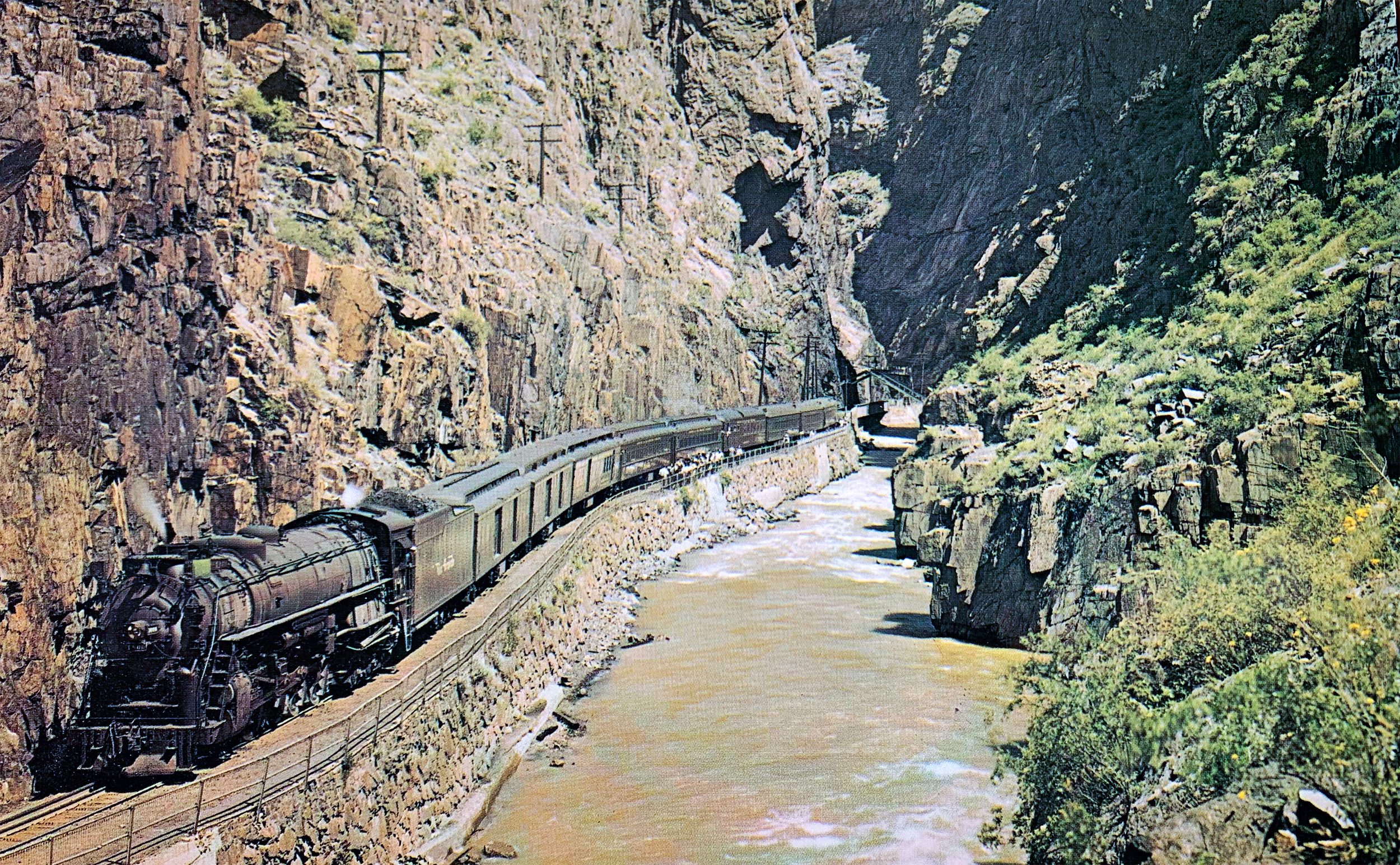 Rio Grande 4-8-4 #1800 (M-68) is stopped with the "Scenic Limited" at the famous Hanging Bridge within Colorado's breathtaking Royal Gorge in the summer of 1945. Otto Roach photo. American-Rails.com collection.
Rio Grande 4-8-4 #1800 (M-68) is stopped with the "Scenic Limited" at the famous Hanging Bridge within Colorado's breathtaking Royal Gorge in the summer of 1945. Otto Roach photo. American-Rails.com collection.The conflict had nearly resulted in a full-scale war with noted law man, Bat Masterson, employed under the Santa Fe to protect construction gangs. There were armed posse on both sides and Rio Grande forces even built forts in an attempt to ward off their rivals.
The fighting exhausted Palmer's resources, forcing him to briefly lease his railroad to the Santa Fe. The agreement took effect on December 13, 1878 but lasted mere months before being canceled, following a Colorado court order, on April 27, 1879.
The Supreme Court's decision led to the "Treaty of Boston" signed by both parties on March 27, 1880. It ended hostilities and each railroad agreed to stay out of the other's territory (later broken by both). The Rio Grande was also awarded AT&SF's completed work through the gorge, purchased for $1.4 million.
The notorious tycoon, Jay Gould, is also credited for ending the fighting; he had effectively gained control of the D&RG leading up to the treaty and worked as an intermediary in negotiating peace.
With this dispute over, Palmer turned his attention back towards expansion. He remained focused on a southern route as far as Santa Fe, New Mexico, the western terminus of the busy Santa Fe Trail.
System Map (1940)
It extended south from Alamosa, reaching Espanola on December 30, 1880. Just over six years later the line was finished into the fabled trading post on January 8, 1887. Unfortunately, the "Chili Line" was never particularly profitable.
It was riddled with curves as sharp as 22 degrees and grades as steep as 4%. Furthermore, the AT&SF already served Santa Fe over a standard-gauge branch that had been in operation since 1880. In later years lumber was the primary commodity before Rio Grande had enough and abandoned the line during 1941.
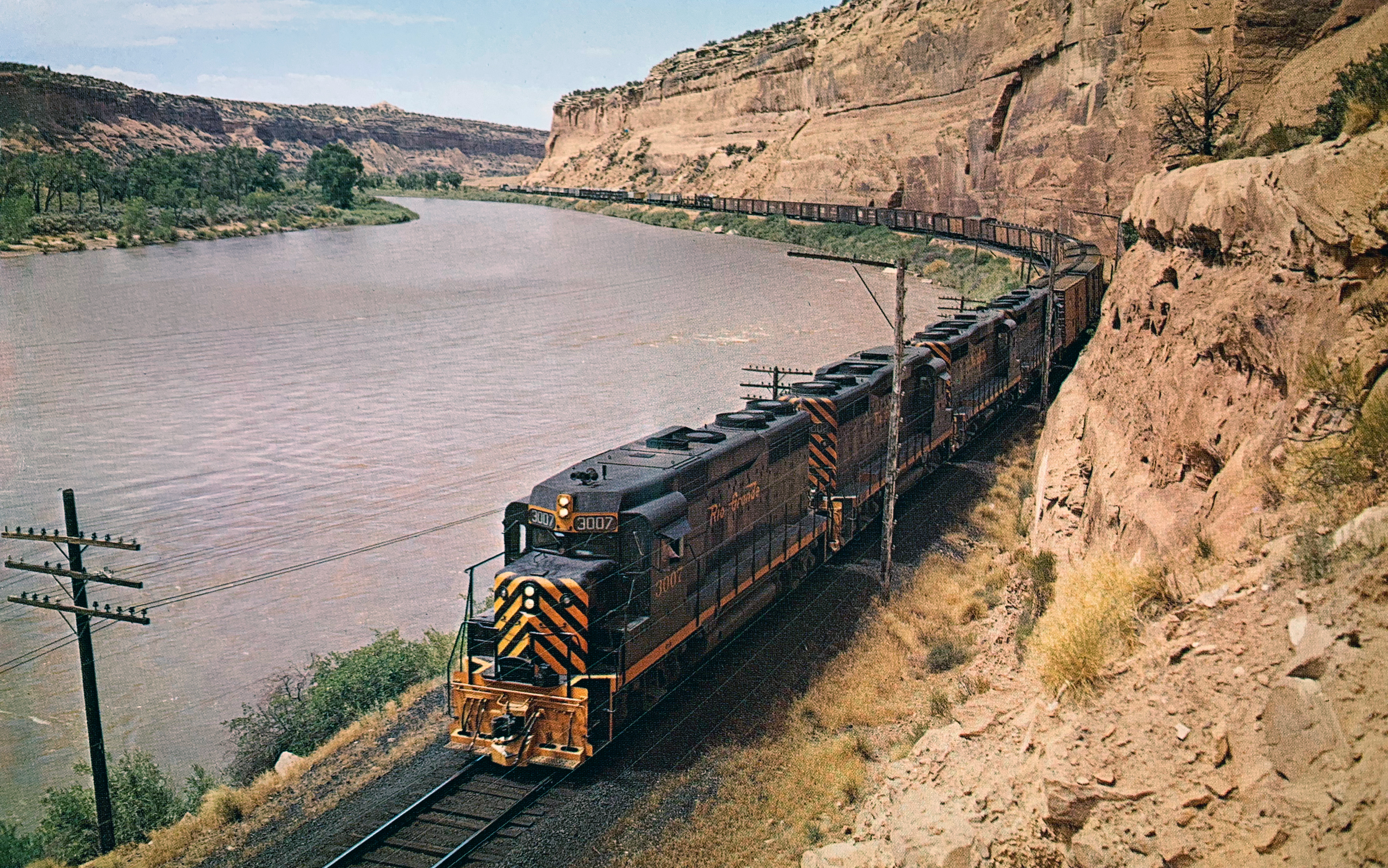 A quartet of new Rio Grande GP30's head east with their train along the Colorado River within Colorado's beautiful Ruby Canyon during the summer of 1962. Ed Roe photo. American-Rails.com collection.
A quartet of new Rio Grande GP30's head east with their train along the Colorado River within Colorado's beautiful Ruby Canyon during the summer of 1962. Ed Roe photo. American-Rails.com collection.The 1880's were a banner decade for the D&RG as it exploded in size:
- Heading west from Antonito it crossed 10,015-foot Cumbres Pass and arrived in Durango on July 27, 1881.
- Silverton was reached a year later, offering direct service into San Juan mining district.
- Some years later, in 1905, a standard-gauge branch extending southward into Farmington, New Mexico was purchased. When the Rio Grande gave up its intentions of converting everything west of Antonito to standard-gauge, the Farmington Branch was changed to narrow-gauge in 1923.
- West of Alamosa another mining branch opened to Creede in 1891; extending beyond Cañon City and passing through the Royal Gorge, construction gangs reached the very important mining camp of Leadville in 1880.
- This was followed by continuing northward over 10,433-foot Tennessee Pass in 1881 to the small mining community of Red Cliff (when opened, it was highest standard-gauge line in the country).
Interestingly, for the time being management elected not to continue towards Utah from this point but, instead, opted for a more southerly route. The decision was driven primarily by additional coal traffic from mines located near Crested Butte. At Salida, the rail-head was extended westward to Gunninson (1881) before it turned north from Montrose.
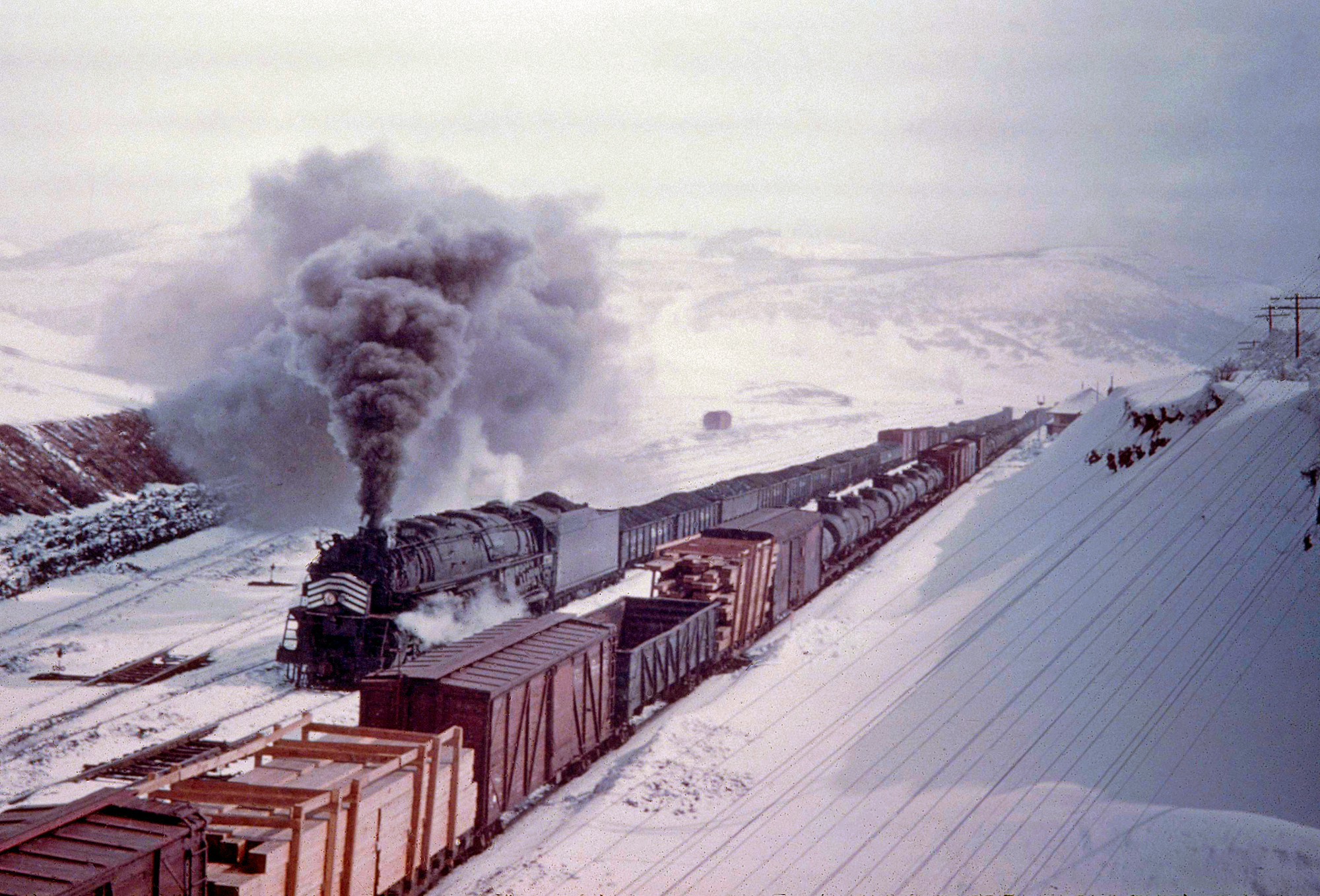 Rio Grande 4-6-6-4 #3712 has crested Utah's Soldier Summit with a westbound freight during the 1950s. Ed Olsen photo. American-Rails.com collection.
Rio Grande 4-6-6-4 #3712 has crested Utah's Soldier Summit with a westbound freight during the 1950s. Ed Olsen photo. American-Rails.com collection.This small town, which later became a junction for the Ouray Branch (completed in 1887 to serve silver mines), sat at about the midway point to Grand Junction (reached on November 22, 1882). A month later, on December 19th, the railroad arrived at the state line but could build no further until corporate charters were received to enter Utah.
Denver & Rio Grande Western Railway
As a result, the Denver & Rio Grande Western Railway was organized on July 21, 1881 with rights to build from the state line to Salt Lake City via Green River, Soldier Summit, and Provo.
To aid in this effort, an earlier charter known as the Sevier Valley Railway was acquired along with three other small short lines; the Bingham Canyon & Camp Floyd (BC&CF), Wasatch & Jordan Valley (W&JV), and Utah & Pleasant Valley (U&PV). All were originally built to serve either coal, silver, or copper mines situated south and east of Salt Lake City.
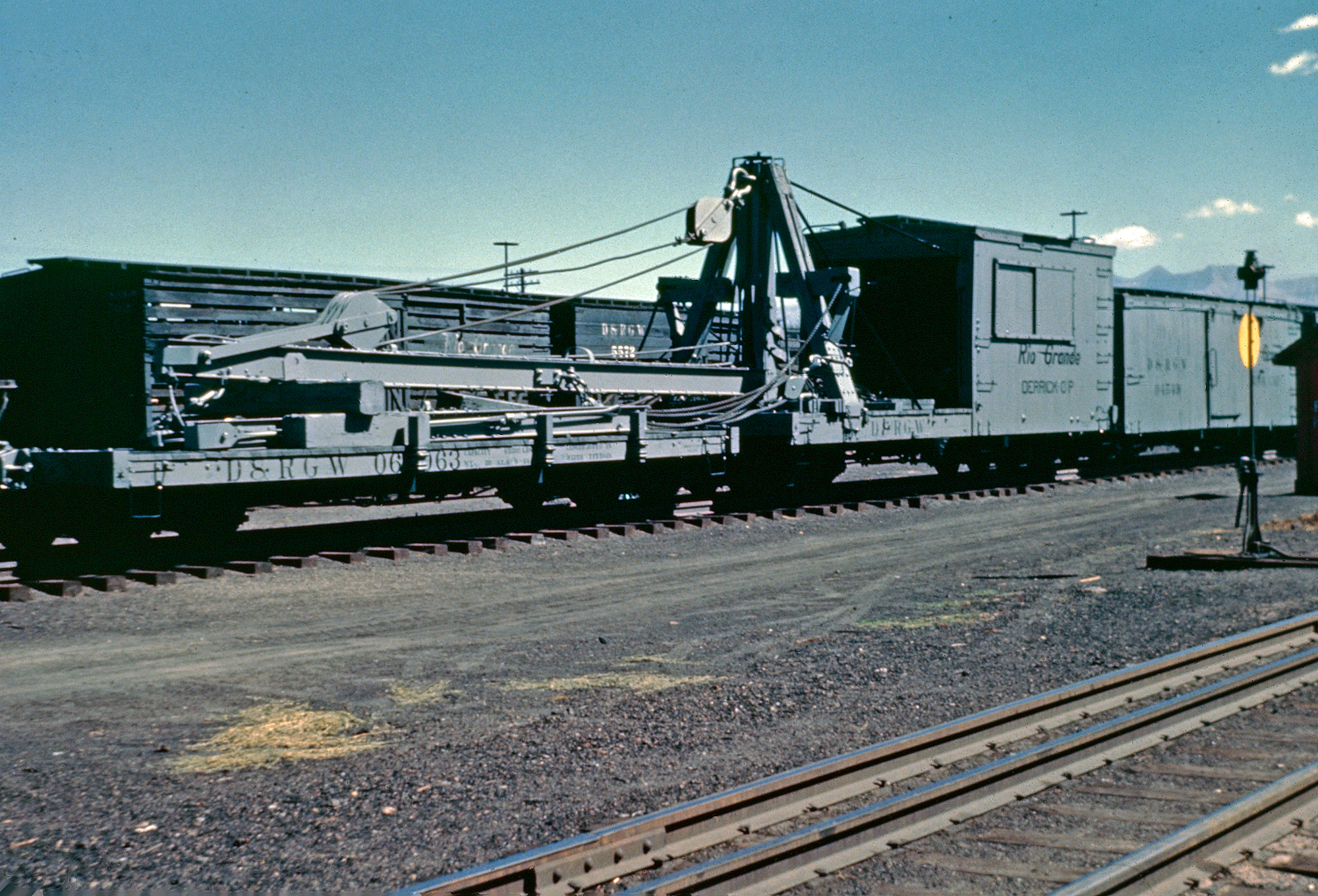 Rio Grande steam derrick "OP" lays over near the depot in Alamosa, Colorado in September, 1944. Author's collection.
Rio Grande steam derrick "OP" lays over near the depot in Alamosa, Colorado in September, 1944. Author's collection.The U&PV proved most important; it had opened 55 miles between Springville and Scofield by November of 1879, which was extended further north to Provo in October of 1880.
When the D&RGW finished a disconnected segment between Provo and Salt Lake City it used part of the U&PV over Soldier Summit as part of its main line into Colorado.
Its first task was to improve the original U&PV alignment over the summit before completing the railroad to the state line on December 19, 1882.
Just a few months later, on May 12, 1883, a short branch was finished beyond Salt Lake City to Ogden which established a transcontinental connection with the Central Pacific/Southern Pacific.
It seems the Rio Grande was consistently caught up in one bureaucratic mess after another, a situation that persisted well into the 20th century. Fighting with the Santa Fe had only been over for a few years when strained finances led to Palmer resigning the D&RG's presidency on August 9, 1883.
He moved on to lead subsidiary D&RGW and was replaced by Frederick Lovejoy. The two went to court over philosophical differences regarding the D&RG's perceived neglected state, which led to the railroads' physical connection being severed just inside the Colorado state line.
When the D&RG entered receivership on July 12, 1884, a result of over-exuberant expansion, it elected not to renew its D&RGW lease following its reorganization as the Denver & Rio Grande Railroad on July 14, 1886; the move was made official on July 31st after which time Palmer began improvements on his end.
Rio Grande Western Railway
He chartered the State Line & Denver Railway for the purpose of purchasing the D&RG from Grand Junction to the Utah state line. He then merged it with the Denver & Rio Grande Western during June of 1889, forming the Rio Grande Western Railway.
Next, the work of converting the entire network to standard-gauge was carried out; the main line from Ogden to Grand Junction was completed on June 11, 1890 with the branches finished the following year.
One final, noteworthy expansion in Utah occurred about a decade later when the Manti Branch was continued down the Sevier River to Marysvale in 1900.
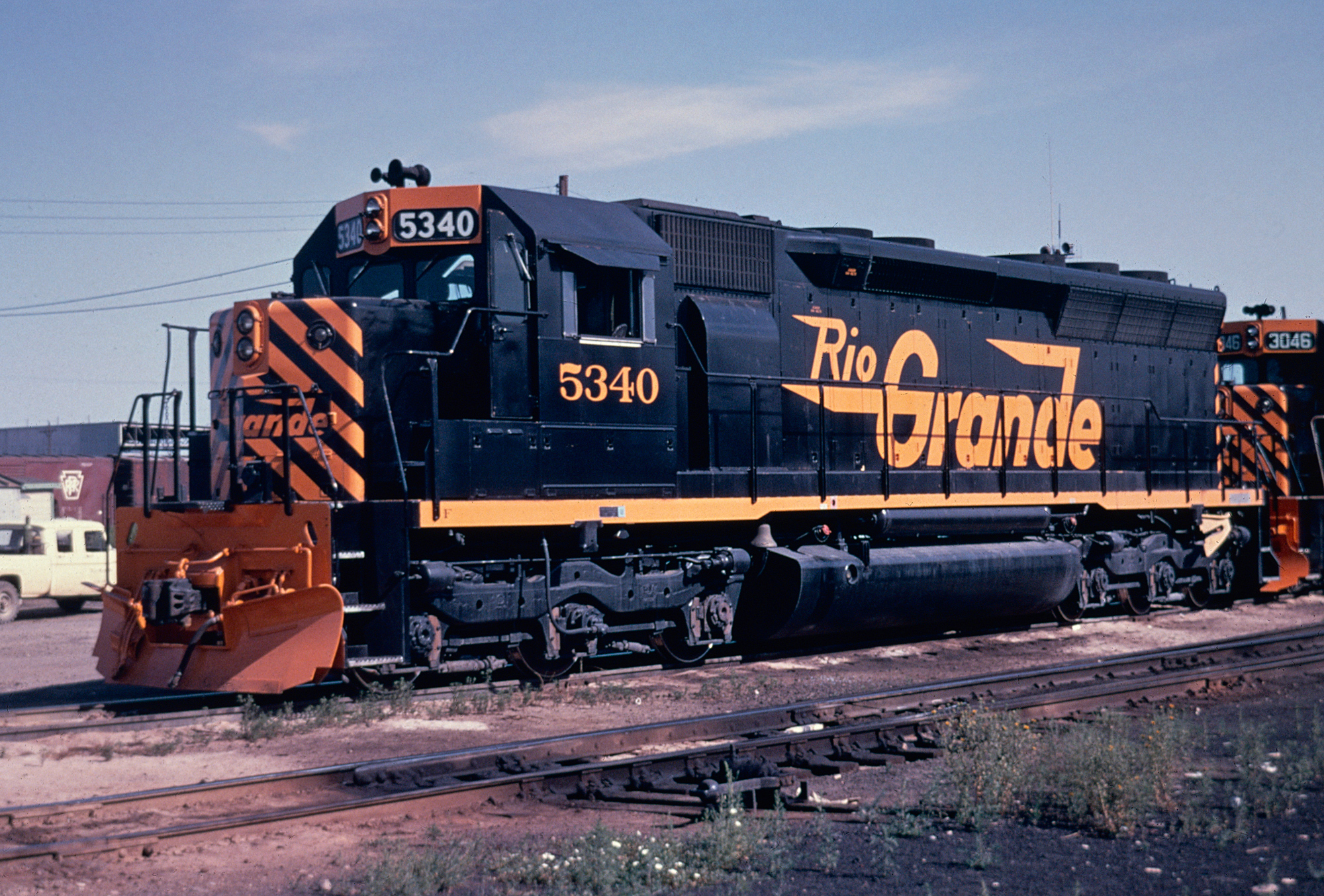 Rio Grande SD45 #5340 and GP35 #3046 in Denver, Colorado; May, 1968. Robert Eastwood, Jr. photo. American-Rails.com collection.
Rio Grande SD45 #5340 and GP35 #3046 in Denver, Colorado; May, 1968. Robert Eastwood, Jr. photo. American-Rails.com collection.During this time the Denver & Rio Grande had also been expanding. Under the leadership of David Moffat, it first built from Red Cliff to Glenwood Springs in an effort to ward off a threat from the standard-gauge Colorado Midland Railway (CM).
The line was completed on October 6, 1887 and a month later, reached to the silver camp of Aspen (November 1st). In 1889 rails were pushed further west to Rifle as officials eyed Grand Junction and the opening of a secondary main line.
At this point the CM and D&RG elected to work together on the project, finishing the connector on November 14, 1890. While Palmer was converting his the D&RGW, his cross-border competitors were doing the name.
The D&RG's narrow-gauge system peaked in 1887 at 1,673 miles. So extensive was its 3-foot network that in 1890 it had only 64 miles of standard-gauge track in operation.
This figure rapidly increased over the following decade as major systems wanted to utilize the D&RG as a through route between Denver and Salt Lake City.
Once officials recognized (particularly after the Sherman Silver Purchase Act was repealed by President Grover Cleveland in 1893) their railroad's potential in this regard, efforts at conversion were hastened; the Denver-Grand Junction section was completed on November 14, 1890 and by 1900 more than 1,000 miles were standard-gauged.
This number continued to increase in the succeeding years. Surprisingly, there remained a few holdouts until well after World War II, most notably within the San Juan district west of Antonito which remained unchanged until the final load of freight left for Alamosa on August 29, 1968. It contained 14 loads of lumber.
Afterwards, much of this trackage was sold to the states of Colorado and New Mexico for a tourist attraction. Today they are operated as the Durango & Silverton Narrow-Gauge and Cumbres & Toltec Scenic.
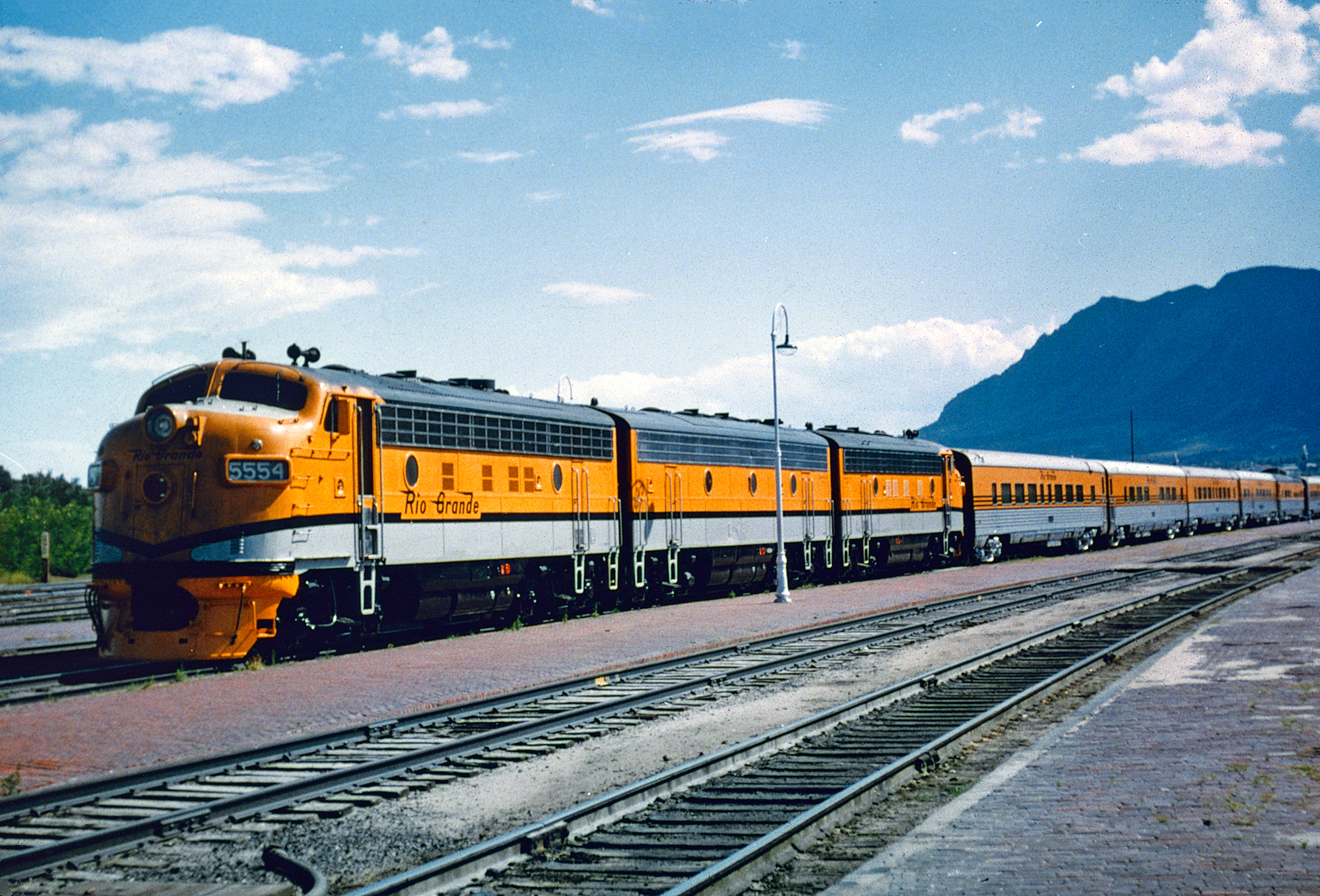 Rio Grande F7A #5554 is ahead of the "Royal Gorge" stopped in Colorado Springs on August 5, 1965. Ed Fulcomer photo. American-Rails.com collection.
Rio Grande F7A #5554 is ahead of the "Royal Gorge" stopped in Colorado Springs on August 5, 1965. Ed Fulcomer photo. American-Rails.com collection.Modern Network
In 1896, Gould's empire was handed over to his son, George, who continued his father's transcontinental ambitions. At this time he controlled the Missouri Pacific, Wabash, Western Maryland, Wheeling & Lake Erie, and the Rio Grande. George is credited with reuniting the D&RG and Rio Grande Western under common management by acquiring stock control of the latter in February of 1901.
- To simply his corporate structure, Gould merged the Rio Grand Western into the D&RG in August of 1908. -
However, his decision to use the two in funding the Western Pacific's construction saddled both with heavy debt for decades to come. The company generally struggled under Gould's control; it not only dealt with crushing financial burdens but was also left to its own affairs resulting in deferred maintenance and relatively poor management.
When the financial Panic of 1907 struck, Gould's financing collapsed, and along with it his transcontinental dreams. One by one his properties slipped into bankruptcy, including the Missouri Pacific in 1915 which held some 30% of Rio Grande's stock.
Rio Grande Southern Railroad
Of Colorado's numerous railroads built to serve the legendary San Juan mining district, one of the more noteworthy was the Rio Grande Southern (RGS).
This system was incorporated on November 5, 1889 and promoted by Otto Mears. By that time he had already been involved with various ventures related to the mining industry.
The RGS opened from a connection with the D&RG at Durango to another connection at Ridgway (162 miles) on January 2, 1892.
Its main line was a zigzag affair; from the north at Ridgway it wound its way through Placerville, headed south, then southwest to Dolores, and turned roughly due east back into Durango.
While it was a fascinating operation (making it a popular subject to model), especially its crossing of 10,250-foot Lizard Head Pass, the steep grades and sharp curves made operations extremely difficult. It was a profitable carrier until the Sherman Silver Purchase Act was repealed on June 30, 1893.
This caused tonnage to drop by more than half and it entered receivership on August 2, 1893. D&RG's president, Edward Jeffrey, was made receiver which effectively gave Rio Grande control.
Rio Grande Southern exited receivership on December 1, 1895 and despite the traffic losses did relatively well until the markets crashed in October of 1929.
This led to another bankruptcy on December 11th and an end to Rio Grande's involvement. It failed to escape receivership for more than 20 years as the courts did their best to keep the company solvent.
It survived on government loans and remaining zinc mining until operations ceased entirely on December 17, 1951. The following August and September its network was dismantled.
Then, the United States Railroad Administration took over the industry, made effective at noon on December 28, 1917. The directive was ordered by President Woodrow Wilson in response to fears of national gridlock.
Unfortunately, the government did no better at maintaining fluid operations than the private sector, resulting in rundown equipment and inadequately maintained equipment. This issue, coupled with its crushing debt and complicated corporate structure, led to the D&RG's receivership on January 25, 1918.
The Transportation Act made effective February 28, 1920 returned the industry to private ownership. The Denver & Rio Grande Western Railroad was subsequently organized to acquire the D&RG's assets, taking formal control on August 1, 1921. Financial struggles continued and a second bankruptcy occurred on July 21, 1922.
It was again reorganized on October 29, 1924 but this time carried the same name. As the company's situation remained uncertain it built one of the country's great engineering feats, thanks largely to funding provided through the city of Denver and federal Reconstruction Finance Corporation loans.
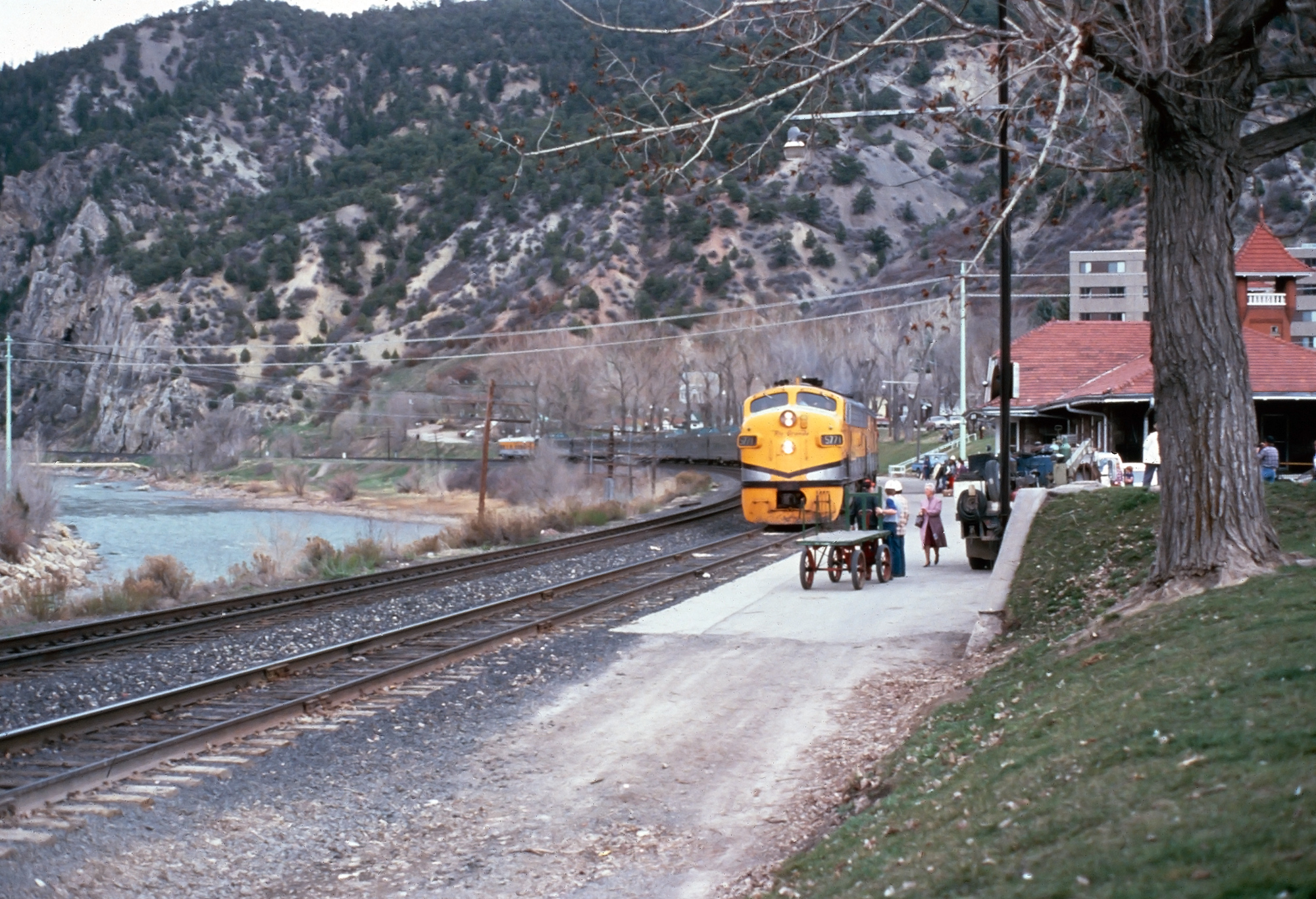 Rio Grande F9A #5771 has arrived at Glenwood Springs, Colorado with the westbound "Rio Grande Zephyr" during the 1970s. The Colorado River is visible at left. American-Rails.com collection.
Rio Grande F9A #5771 has arrived at Glenwood Springs, Colorado with the westbound "Rio Grande Zephyr" during the 1970s. The Colorado River is visible at left. American-Rails.com collection.In 1930, the D&RGW acquired a significant interest in the Denver & Salt Lake Railway (D&SL), a project initially launched by David Moffat in 1902 to build a secondary route from Denver to Salt Lake City. He had run out of money by 1913 having only reached Craig, Colorado.
According to Mike Schafer's took, "Classic American Railroads," part of the D&SL crossed 11,680-foot Rollins Pass. It was situated somewhat northwest of Denver and was only surmounted via a series of tortuous switchbacks, carrying grades as high as 4%.
So difficult was this stretch that 23 miles of railroad were required to connect two points just 8 miles apart. To improve operations the city agreed in 1922 to help fund a new tunnel under James Peak. Following six years of work the $18 million project was completed in 1928 and named for D&SL's founder.
Passenger Trains
California Zephyr: (Chicago - Denver - Salt Lake City - San Francisco)
Colorado Eagle: (St. Louis - Pueblo - Denver)
Exposition Flyer: Operated between Oakland, California and Chicago in conjunction with the Burlington and Western Pacific until 1949 (replaced by the CZ).
Mountaineer: (Denver - Montrose, Colorado)
Panoramic: (Denver - Odgen)
Prospector: (Denver - Salt Lake City)
Rio Grande Zephyr: Replacement for the CZ between 1970 and 1983 it operated between Denver and Ogden.
Royal Gorge: (Denver - Pueblo - Ogden)
San Juan: (Alamosa - Durango, Colorado)
The Ski Train: (Denver - Winter Park)
The Silverton: (Durango - Silverton, Colorado)
The Yampa Valley: (Denver - Craig, Colorado)
Moffat Tunnel was 6.1 miles in length and reduced the trip from hours to a mere 15 minutes. After the Rio Grande gained control it completed a short connector in 1934 known as the Dotsero Cutoff which ran from D&SL at Bond to D&RGW's Tennessee Pass main line at Dotsero.
This essentially completed Rio Grande's modern network which contained 2,569 route miles (including standard, narrow, and third-rail gauge). Alas, with the ongoing depression and lingering monetary troubles another bankruptcy occurred on November 1, 1935.
Diesel Roster
American Locomotive Company
| Model Type | Road Number | Date Built | Quantity |
|---|---|---|---|
| S2 | 101-119 | 9/1941-5/1944 | 19 |
| RS3 | 5200-5204 | 6/1951 | 5 |
| PA1 | 600A-601A, 600C-601C | 1/1947-4/1947 | 4 |
| PB1 | 600B-601B | 1/1947-2/1947 | 2 |
Baldwin Locomotive Works
| Model Type | Road Number | Date Built | Quantity |
|---|---|---|---|
| VO-660 | 66-74 | 5/31/1941-8/30/1941 | 9 |
Electro-Motive Corporation/Electro-Motive Division
| Model Type | Road Number | Date Built | Quantity |
|---|---|---|---|
| SW1200 | 130-139 | 1965 | 10 |
| FTA | 540A-551A, 540D-551D | 1/1942-10/1944 | 24 |
| FTB | 540B-551B, 540C-551C | 1/1942-10/1944 | 24 |
| F3A | 552A-554A, 552D-554D | 11/1946 | 6 |
| F3B | 552B-554B, 552C-554C | 11/1946 | 6 |
| F7A | 555A-564A, 555D-564D | 2/1949-7/1949 | 20 |
| F7B | 555B-564B, 555C-564C | 2/1949-7/1949 | 20 |
| F7A | 555A-564A, 555D-564D | 2/1949-7/1949 | 20 |
| F7A | 5651, 5654, 5661, 5664, 5671, 5674, 5681, 5684, 5691, 5694, 5701, 5704, 5711, 5714, 5721, 5724, 5731, 5734, 5741, 5744, 5751, 5754, 5761, 5764 | 6/1950-7/1952 | 24 |
| F7B | 5652-5653, 5662-5663, 5672-5673, 5682-5683, 5692-5693, 5702-5703, 5712-5713, 5722-5723, 5732-5733, 5742-5743, 5752-5753, 5762 | 6/1950-7/1952 | 23 |
| GP30 | 3001-3028 | 4/1962-2/1963 | 28 |
| GP35 | 3029-3050 | 5/1964-1/1965 | 22 |
| GP40 | 3051-3093, 3131-3153 | 1/1966-4/1985 | 66 |
| GP40-2 | 3094-3130 | 4/1972-3/1983 | 37 |
| GP60 | 3154-3156 | 5/1990 | 3 |
| GP7 | 5101-5113 | 10/1950-6/1952 | 13 |
| SD7 | 5300-5304 | 5/1953 | 5 |
| SD9 | 5305-5314 | 7/1957 | 10 |
| SD45 | 5315-5340 | 1/1967-3/1968 | 26 |
| SD40T-2 | 5341-5413 | 10/1974-3/1980 | 73 |
| SD50 | 5501-5517 | 8/1984-9/1984 | 17 |
| F9B | 5762-5263, 5772-5773 | 9/1955 | 4 |
| F9A | 5771, 5774 | 9/1955 | 2 |
| GP9 | 5901-5904, 5911-5914, 5921-5924, 5931-5934, 5941-5944, 5951-5954 | 4/1955-6/1956 | 24 |
| NW2 | 7000 | 1/1941 | 1 |
Davenport Locomotive Works
| Model Type | Road Number | Date Built | Quantity |
|---|---|---|---|
| 30-Ton (Narrow-Gauge) | 50 | 1963 | 1 |
Fairbanks-Morse
| Model Type | Road Number | Date Built | Quantity |
|---|---|---|---|
| H-10-44 | 120-123 | 4/1948 | 4 |
| H-15-44 | 150-152 | 1/1948-2/1948 | 3 |
General Electric
| Model Type | Road Number | Date Built | Quantity |
|---|---|---|---|
| 44-Ton | 38-43 | 8/1941-9/1942 | 6 |
Krauss-Maffei
| Model Type | Road Number | Date Built | Quantity |
|---|---|---|---|
| ML-4000 (Cab Unit) | 4001-4003 | 6/1961 | 3 |
Steam Roster (Modern Class Designations)
Standard-Gauge Locomotives
| Road Number(s) | Class | Arrangement | Builder | Date Built/Notes |
|---|---|---|---|---|
| 01 | C-41 | 2-8-0T | Baldwin | 1900 |
| 1 | Y-21 | Class C, 3-Truck Shay | Lima | 8/1924 |
| 2 | Y-25 | Class C, 3-Truck Shay | Lima | 10/1925 |
| 3 | Y-32 | Class C, 3-Truck Shay | Lima | 12/1934 |
| 4-5 | Y-33 | Class C, 3-Truck Shay | Lima | 10/1925, 5/1936 |
| 20-22 | S-23 | 0-6-0 | Alco | 1900 |
| 50-59 | S-33 | 0-6-0 | Baldwin | 1906-1907 |
| 60-62 | S-33 | 0-6-0 | Alco | 1909 |
| 500-501 | T-17 | 4-6-0 | Rome | 1890-1891 |
| 506-538 | T-18 | 4-6-0 | Baldwin | 1887-1891 |
| 520-521, 525-528 | T-19 | 4-6-0 | Baldwin | 1892-1898 |
| 530-533 | T-24 | 4-6-0 | Alco | 1901 |
| 535-541, 545-546 | T-26 | 4-6-0 | Baldwin | 1898 |
| 542-544 | T-26 | 4-6-0 | Denver & Rio Grande | 1897 |
| 575-579 | G-20 | 2-6-0 | Baldwin | 1890-1891 |
| 590-591 | G-28 | 2-6-0 | Baldwin | 1898 |
| 592-597 | G-28 | 2-6-0 | Alco | 1901 |
| 600-626 | C-26 | 2-8-0 | Baldwin | 1889-1892 |
| 630-691 | C-28 | 2-8-0 | Baldwin | 1888-1890 |
| 720-739 | T-28 | 4-6-0 | Brooks | 1899 |
| 750-759 | T-31 | 4-6-0 | Baldwin | 1902 |
| 760-761 | T-31 | 4-6-0 | Brooks | 1908-1909 |
| 762-793 | T-29 | 4-6-0 | Alco/Brooks | 1908-1909 |
| 795-796 | T-33 | 4-6-0 | Alco | 1907 |
| 800-805 | P-44 | 4-6-2 | Baldwin | 1913 |
| 900-903 | C-38 | 2-8-0 | Richmond | 1900 |
| 915-925 | C-39 | 2-8-0 | Baldwin | 1912, 1905 |
| 930-934 | C-40 | 2-8-0 | Baldwin | 1901 |
| 940-944 | C-40 | 2-8-0 | Alco/Richmond | 1901 |
| 950-964 | C-41 | 2-8-0 | Baldwin | 1900 |
| 1000-1029 | C-41 | 2-8-0 | Baldwin | 1902 |
| 970-973 | C-42 | 2-8-0 | Richmond | 1900 |
| 1031-1039 | C-43 | 2-8-0 | Alco | 1910 |
| 1131-1199 | C-48 | 2-8-0 | Alco | 1906-1908 |
| 1200-1213 | K-59 | 2-8-2 | Baldwin | 1912 |
| 1220-1227 | K-63 | 2-8-2 | Lima | 1915 |
| 1228-1229 | K-63 | 2-8-2 | Alco | 1916 |
| 1400-1409 | F-81 | 2-10-2 | Alco | 1916 |
| 1501-1510, 1521-1530 | M-67 | 4-8-2 | Alco | 1922-1923 |
| 1511-1520 | M-78 | 4-8-2 | Alco | 1923 |
| 1700-1713 | M-64 | 4-8-4 | Baldwin | 1929 |
| 1800-1804 | M-68 | 4-8-4 | Baldwin | 1937 |
| 3300-3308 | L-62 | 2-6-6-2 | Alco | 1910 |
| 3350-3351 | L-76 | 2-6-6-2 | Alco | 1916 |
| 3360-3375 | L-77 | 2-6-6-0 | Alco | 1908-1916 |
| 3400-3415 | L-95 | 2-8-8-2 | Alco | 1913 |
| 3500-3509 | L-107 | 2-8-8-2 | Alco | 1923 |
| 3610-3619 | L-132 | 2-8-8-2 | Alco | 1930 |
| 3700-3714 | L-105 | 4-6-6-4 | Baldwin | 1938-1942 |
| 3800-3805 | L-97 | 4-6-6-4 | Alco | 1943 |
Narrow-Gauge Locomotives
| Road Number(s) | Class | Arrangement | Builder | Date Built/Notes |
|---|---|---|---|---|
| 166-177 | T-12 | 4-6-0 | Baldwin | 1883-1884 |
| 200-227 | C-16 | 2-8-0 | Grant | 1881-1882 |
| 228-229, 240-241 | C-16 | 2-8-0 | Baldwin | 1877-1882 |
| 262-263, 265-274 | C-16 | 2-8-0 | Baldwin | 1882 |
| 276, 278, 280-286 | C-16 | 2-8-0 | Baldwin | 1882 |
| 300-306 | C-17 | 2-8-0 | Baldwin | 1887-1895 |
| 315-320 | C-18 | 2-8-0 | Baldwin | 1895-1897 |
| 340-349 | C-19 | 2-8-0 | Baldwin | 1881 |
| 360-361 | C-21 | 2-8-0 | Baldwin | 1900 |
| 375 | C-25 | 2-8-0 | Baldwin | 1903 |
| 450-464 | K-27, "Mudhens" | 2-8-2 | Baldwin | 1903 |
| 470-479 | K-28 | 2-8-2 | Alco | 1923 |
| 480-489 | K-36 | 2-8-2 | Baldwin | 1925 |
| 490-499 | K-37 | 2-8-2 | Denver & Rio Grande Western | 1928-1930 |
Class K-27 ("Mudhens")
During the early 20th century the then Denver & Rio Grande began acquiring more powerful 2-8-2s for use on this trackage as traffic began to steadily increase.
The first batch of Mikados to arrive were the Class K-27's, which became affectionately known as "Mudhens" by railroad employees. Over the years this class was rebuilt a handful of times and were finally slowly retired beginning in the 1930s as newer, more powerful 2-8-2s began supplanting the K-27's.
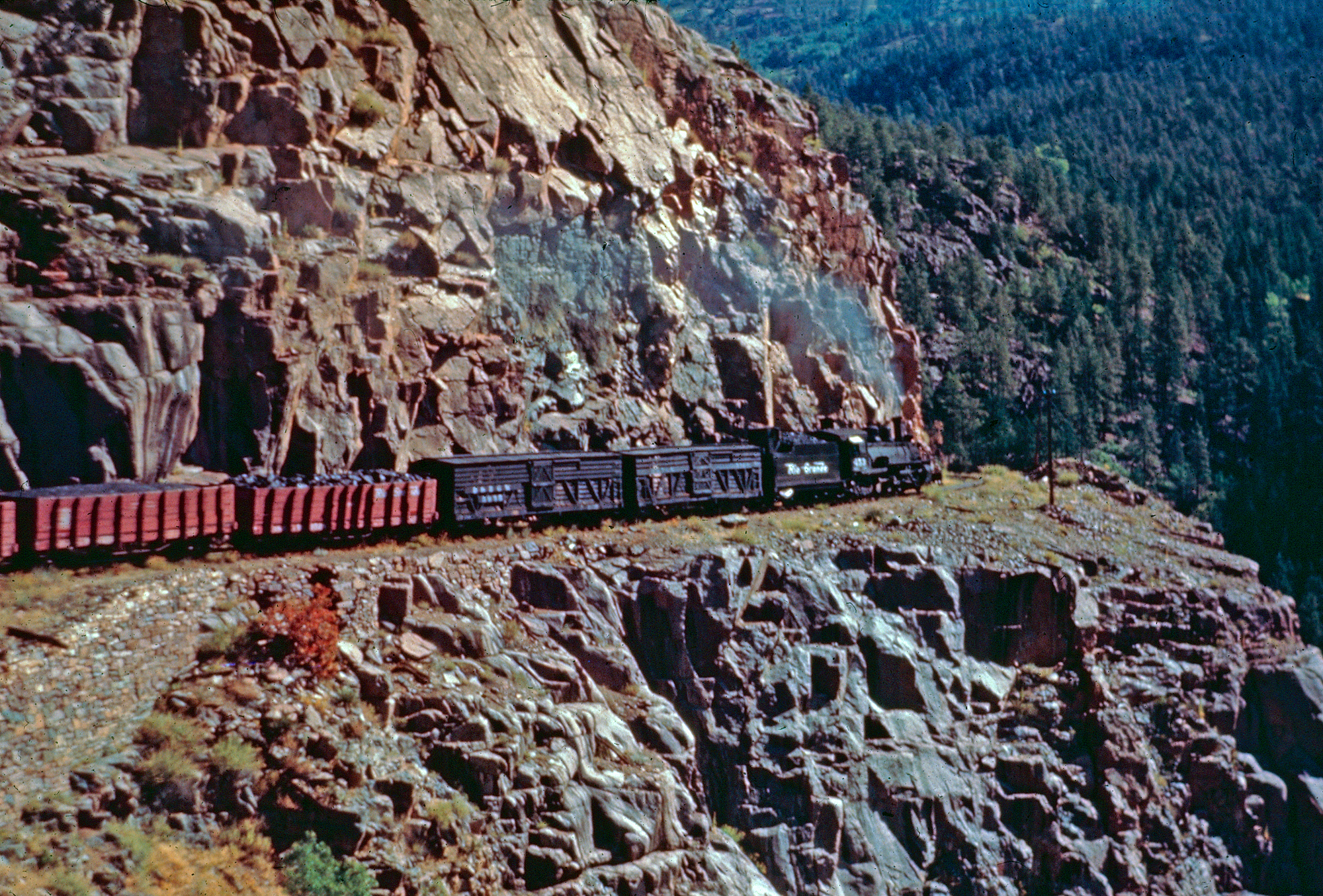 Rio Grande 2-8-2 #453 leads a northbound mixed freight on the Silverton Branch near Rockwood, Colorado in September, 1944. The Mudhen and its train were bound for the end of the line at Silverton. Author's collection.
Rio Grande 2-8-2 #453 leads a northbound mixed freight on the Silverton Branch near Rockwood, Colorado in September, 1944. The Mudhen and its train were bound for the end of the line at Silverton. Author's collection.Today, two survive in the United States and both are currently operational; #464 (pictured in this article) is alive and well on the Huckleberry Railroad in Flint, Michigan and while sister #463 hosts excursions in its home territory along the Cumbres & Toltec Scenic in Colorado.
By the early 1900s the Denver & Rio Grande operated an extensive network of narrow-gauge trackage running south and southwest of Denver.
The D&RG had been built, entirely, as a narrow-gauge system and its dreams of linking to El Paso, and eventually Mexico, were cut short following a fight with the Atchison, Topeka & Santa Fe for use of Raton Pass in northern New Mexico.
This led the railroad to new ownership and eventually a push westward towards Salt Lake City. The company's corporate history is a bit complex and far too detailed to discuss further here. However, through new construction and takeovers the D&RG had reached Salt Lake by 1883.
Following bankruptcy it was renamed the Denver & Rio Grande Western Railroad in 1921 and further improvements and enhancements during the 1920s and 1930s saw a better route completed into Utah (such as the Moffat Tunnel).
Over the years the Rio Grande had upgraded most of its narrow-gauge trackage to standard gauge. However, its lines west and south of Alamosa, Colorado were never upgraded, in part due to traffic losses following the mining industry's collapse during the late 19th century.
In 1903 the D&RG acquired its first new narrow-gauge power for these branch lines in many years from the Baldwin Locomotive Works. The crews are said to have referred to them as "little monsters" since at the time it was the largest new power ever operated on that section of the railroad (previously 2-8-0s and 4-6-0s had done the job).
Listed originally as Class 125 (the Class K-27 designation was used after 1924) the new 2-8-2 Mikados were built as Vauclain Compounds, then a relatively new type of design that carried high and lower pressure cylinders to more efficiently use steam.
Unfortunately, the compounds were too complicated and expensive to maintain (others railroads experienced similar problems using compound steam) resulting in shop forces changing over all fifteen Mikes (numbered 450-464) to simple expansion (exhausted steam only once) between 1907 and 1909.
The origin of their nickname as "Mudhens" has never been fully understood; one version of the story states the term came about because the Mikados were prone to derailments on the tight curves and poorly maintained narrow-gauge trackage. As they skipped and waddled along the ties the locomotive's looked like a hen, giving them their nickname.
However, another version says that because of their low center of gravity and having their counterweights (or cranks) situated beyond the width of the rails (due to their outside frames) they appeared to weave and bob down the rough track giving them the name "Mudhen."
Roster
| Road Number | Builder | Model | Date Built | Disposition |
|---|---|---|---|---|
| 450 | Baldwin | Class K-27 | 1903 | Scrapped, 1/39 |
| 451 | Baldwin | Class K-27 | 1903 | Scrapped, 1/39 |
| 452 | Baldwin | Class K-27 | 1903 | Scrapped, 7/54 |
| 453 | Baldwin | Class K-27 | 1903 | Scrapped, 7/54 |
| 454 | Baldwin | Class K-27 | 1903 | Scrapped, 11/53 |
| 455 | Baldwin | Class K-27 | 1903 | To Rio Grande Southern, 9/39: Scrapped, 1953 |
| 456 | Baldwin | Class K-27 | 1903 | Scrapped, 2/52 |
| 457 | Baldwin | Class K-27 | 1903 | Scrapped, 1/39 |
| 458 | Baldwin | Class K-27 | 1903 | To NdeM, 1941: Scrapped, 1962 |
| 459 | Baldwin | Class K-27 | 1903 | To NdeM, 1941: Retired, 1957 |
| 460 | Baldwin | Class K-27 | 1903 | Scrapped, 1/39 |
| 461 | Baldwin | Class K-27 | 1903 | To Rio Grande Southern, 9/50: Scrapped, 1953 |
| 462 | Baldwin | Class K-27 | 1903 | Scrapped, 5/50 |
| 463 | Baldwin | Class K-27 | 1903 | Acquired by G. Autry, 1955: Donated To City Of Antonito 1972: Restored 1994: Rebuilt In 2001, Returned To Service 2013 |
| 464 | Baldwin | Class K-27 | 1903 | Retired, 1962: To Knott's Berry Farm 1973: To Huckleberry Railroad 1981 |
Whatever the case, the Class K-27's had a mixed level of performance during their service lives. Aside from the derailment issues (which appears to have been mostly corrected after the original 40-pound rail was upgraded with 52-pound rail) the Mike's tended to lose steam caused by their shallow fireboxes with, as one former employee said:
"...little room up front between the grates and the arch. You had to be a good shot with the scoop. Too high and you'd hit the arch and the coal would fall in the middle, too low and the coal would land short of the front. Either way, you end up with a pile about two feet from the front, a pile that would extend from the grates all the way to the arch [and] with nothing burning against the flue sheet."
Still, other former Rio Grande employees said the Mudhens were a joy to operate with responsive throttles and good traction (their tractive effort was rated at around 27,000 pounds). Several additional enhancements took place with the K-27's besides their conversion to simple expansion, all of which occurred during the 1920s.
At this time most were upgraded with superheaters, larger tenders, and piston valves. That decade also witnessed the Rio Grande adding additional, and more powerful, 2-8-2s to the narrow-gauge fleet notably ten new Class K-28's from the American Locomotive Company in 1923 and ten new Class K-36's from Baldwin two years later in 1925.
The railroad also reused boilers once belonging to its 2-8-0 Consolidations and with new frames from Baldwin built ten new 2-8-2s listing them as Class K-37's. Retirement for the Mudhens began in the late 1930s and all were either scrapped or sold by 1954, except one.
Preservation
In 1941 two were acquired by Ferrocarriles Nacionales de México (National de Mexico), Rio Grande #458 and #459. Also, country music singer and actor Gene Autry acquired #463 in 1955, which he later donated to the City of Antonito, Colorado in 1972.
It was restored and returned to service on the Cumbres & Toltec Scenic in 1994, and then rebuilt again beginning in the fall of 2001. That restoration was completed and the locomotive is again operating as of May, 2013.
Finally, #464 was the last to leave the Rio Grande, retired in 1962. It was then acquired by the Knott's Berry Farm of California and then sent to the Huckleberry Railroad in Flint, Michigan where the Mikado still operates today.
Class K-28
The K-28 Mikados were its newest fleet of narrow-gauge 2-8-2s when received in 1923. The little Mikes replaced the fabled K-27 "Mudhens" purchased at the beginning of the 20th century.
These new steam locomotives corrected flaws in the earlier K-27's and were slightly more powerful. The K-28's were well-built machines and proved so reliable that other railroads purchased Mikados based from this design.
Only three examples survived after the end of World War II due to requisitioning related to the war effort. These three locomotives remained in service through the 1950s until they were finally sent into storage as the K-36's and K-37's finished out operation on the San Juan lines in 1967.
Eventually, the trio was donated to the upstart Durango & Silverton Narrow Gauge tourist operation where they remain today.
During the steam era, smaller arrangements like the 2-8-0 and, in particular, the 2-8-2 were favored by the Rio Grande along its San Juan District.
The perky little locomotives provided sufficient power and traction while also able to handle the sharp curves and stiff grades in the region.
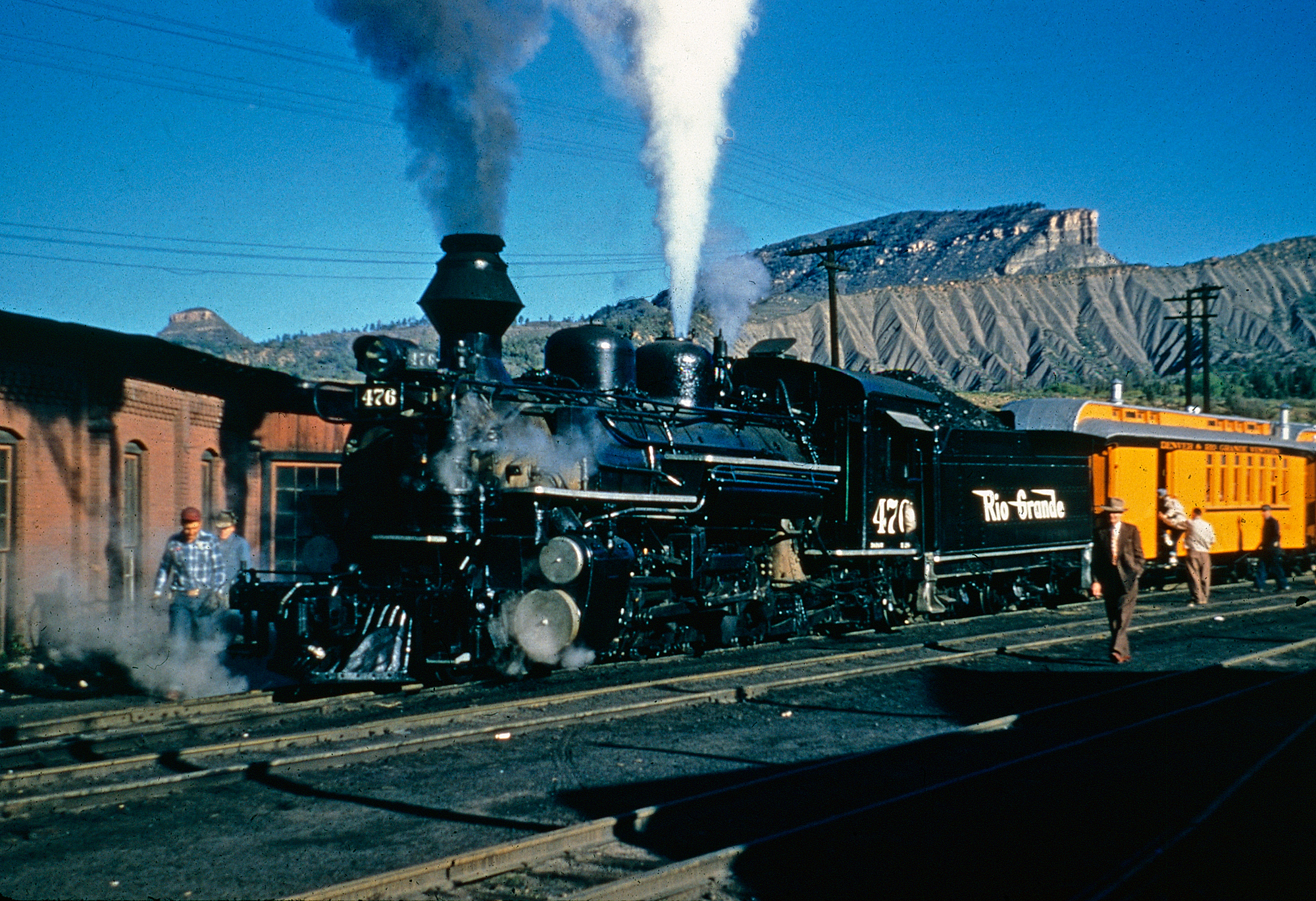 Rio Grande 2-8-2 #476 (K-28) readies to leave Durango, Colorado with a Rocky Mountain Railroad Club Memorial Day excursion on May 31, 1957. American-Rails.com collection.
Rio Grande 2-8-2 #476 (K-28) readies to leave Durango, Colorado with a Rocky Mountain Railroad Club Memorial Day excursion on May 31, 1957. American-Rails.com collection.The Rio Grande's fabled narrow-gauge operations in southern Colorado and northern New Mexico were so unique that they continue to garner attention in books, magazines, and model railroad layouts even today.
They were a fascinating operation that saw steam survive in main line freight until the latter 1960s, long after other Class I's had retired theirs from service.
After the mining industry's decline in the late 19th century, this network of trackage subsisted on a mix of freight traffic (from drilling equipment for the oil industry to various agriculture and less-than-carload movements) and continued to haul passengers through the first half of the 20th century.
Prior to the arrival of the more powerful Mikados, the then Denver & Rio Grande relied on a fleet of 2-6-0s, 4-6-0s, and, in particular, 2-8-0 Consolidations to get the work done. However, as traffic grew during the early 1900s the railroad decided it need to upgrade this fleet in meeting demand.
In 1903 it received a batch of fifteen new 2-8-2 Mikados from the Baldwin Locomotive Works. These steamers were initially listed as Class 125 and were affectionately known as "Mudhens" (although the origin of that name remains unclear even today).
Then the most powerful locomotives operating on the narrow-gauge system, D&RG employees and train crewmen referred to them as "little monsters." The Mudhens had issues, however; notably a shallow firebox that resulted in losing steam while in service.
In general, though, they were reliable and crews enjoyed them. During the 1920s, these Mikados received a number of overhauls and given a new designation as Class K-27.
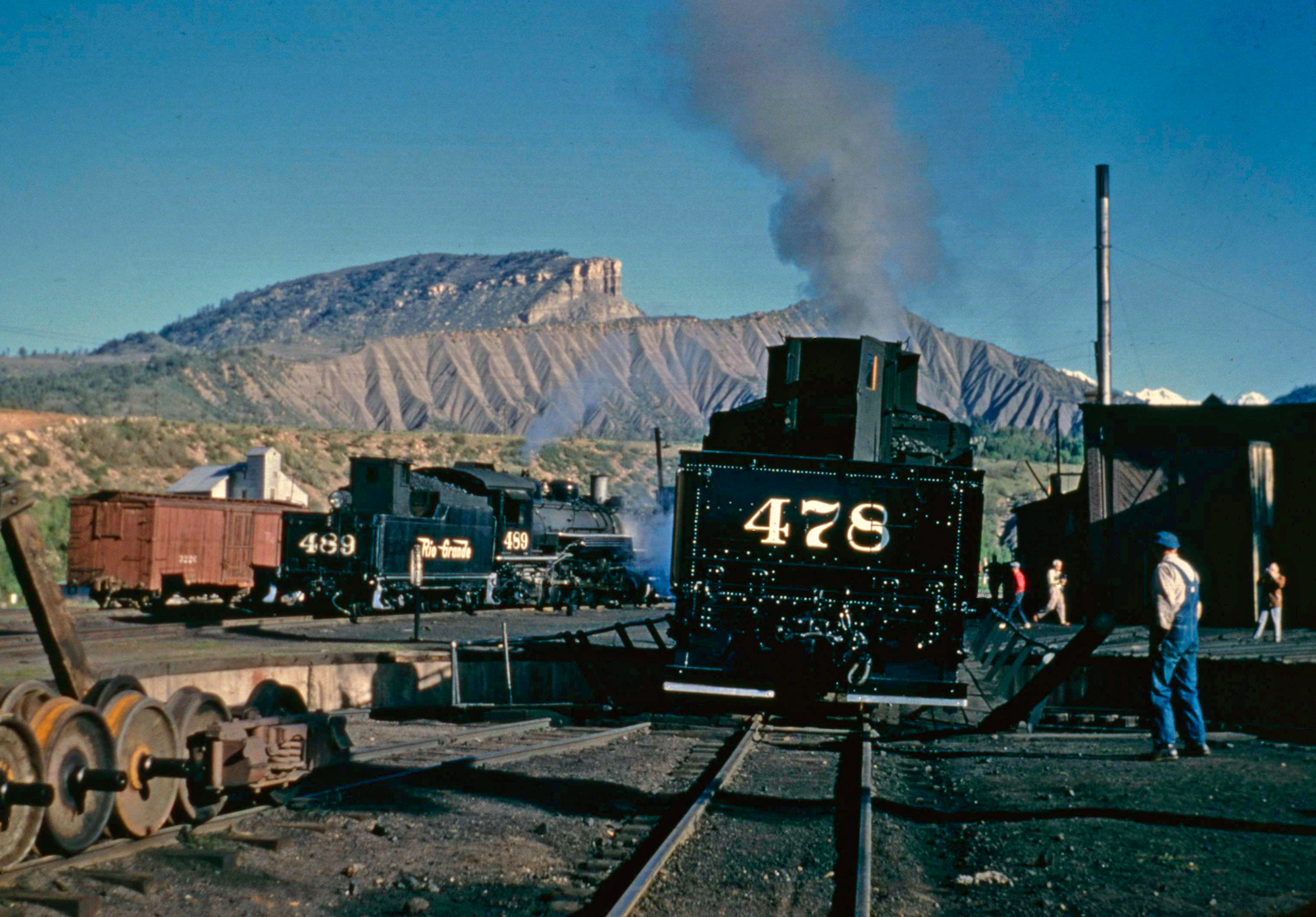 Rio Grande 2-8-2 #478 (K-28) goes for a spin on the turntable at Durango, Colorado as 2-8-2 #489 (K-36) can be seen in the background on June 1, 1957. American-Rails.com collection.
Rio Grande 2-8-2 #478 (K-28) goes for a spin on the turntable at Durango, Colorado as 2-8-2 #489 (K-36) can be seen in the background on June 1, 1957. American-Rails.com collection.By then the Denver & Rio Grande Western (renamed on August 1, 1921 following reorganization) was needing even more new power to replace aging 4-6-0s and 2-8-0s.
During 1923 it received a new batch of ten 2-8-2s from the American Locomotive Company (Alco), numbered 470-479 and given Class K-28.
These latest 2-8-2s offered a slightly better axle loading and additional tractive effort, and their taller drivers (earning them the nickname "Sport Models") meant they could also operate at higher speeds.
Officially, the new K-28's were meant to replace the 4-6-0s in passenger service between Alamosa and Durango, as well as Salida and Gunnison.
The Mikes also carried the last named train to operate on the narrow-gauge network, the San Juan. As a dual-service locomotive, however, they also found work in normal freight assignments.
Roster and Disposition
| Road Number | Builder | Model | Date Built | Disposition |
|---|---|---|---|---|
| 470 | Alco | Class K-28 | 1923 | To US Army as WP&Y 250: Scrapped, 1945 |
| 471 | Alco | Class K-28 | 1923 | To US Army as WP&Y 251: Scrapped, 1945 |
| 472 | Alco | Class K-28 | 1923 | To US Army as WP&Y 252: Scrapped, 1945 |
| 473 | Alco | Class K-28 | 1923 | To D&SNG, 1981 |
| 474 | Alco | Class K-28 | 1923 | To US Army as WP&Y 253: Scrapped, 1945 |
| 475 | Alco | Class K-28 | 1923 | To US Army as WP&Y 254: Scrapped, 1945 |
| 476 | Alco | Class K-28 | 1923 | To D&SNG, 1981 |
| 477 | Alco | Class K-28 | 1923 | To US Army as WP&Y 255: Scrapped, 1945 |
| 478 | Alco | Class K-28 | 1923 | To D&SNG, 1981 |
| 479 | Alco | Class K-28 | 1923 | To US Army as WP&Y 256: Scrapped, 1945 |
Interestingly, most of the K-28's operated for less than twenty years. Following the United States' entrance into World War II, seven were requisitioned by the U.S. Army during the fall of 1942 for use on Alaska's White Pass & Yukon Railroad due to the threat from Japanese attack (notably the Aleutian Island chain).
These locomotives included numbers:
- 470-472
- 474-475
- 477
- 479
The seven Mikes were subsequently renumbered on the WP&Y as 250-256. Following the war the locomotives were not sent back to the Rio Grande and eventually scrapped in Seattle in 1945.
The three K-28's still on the roster (473, 476, and 478) remained in service but were used only sparingly after the 1950s. By then, traffic in this region had declined to the point the railroad was seriously considering outright abandonment.
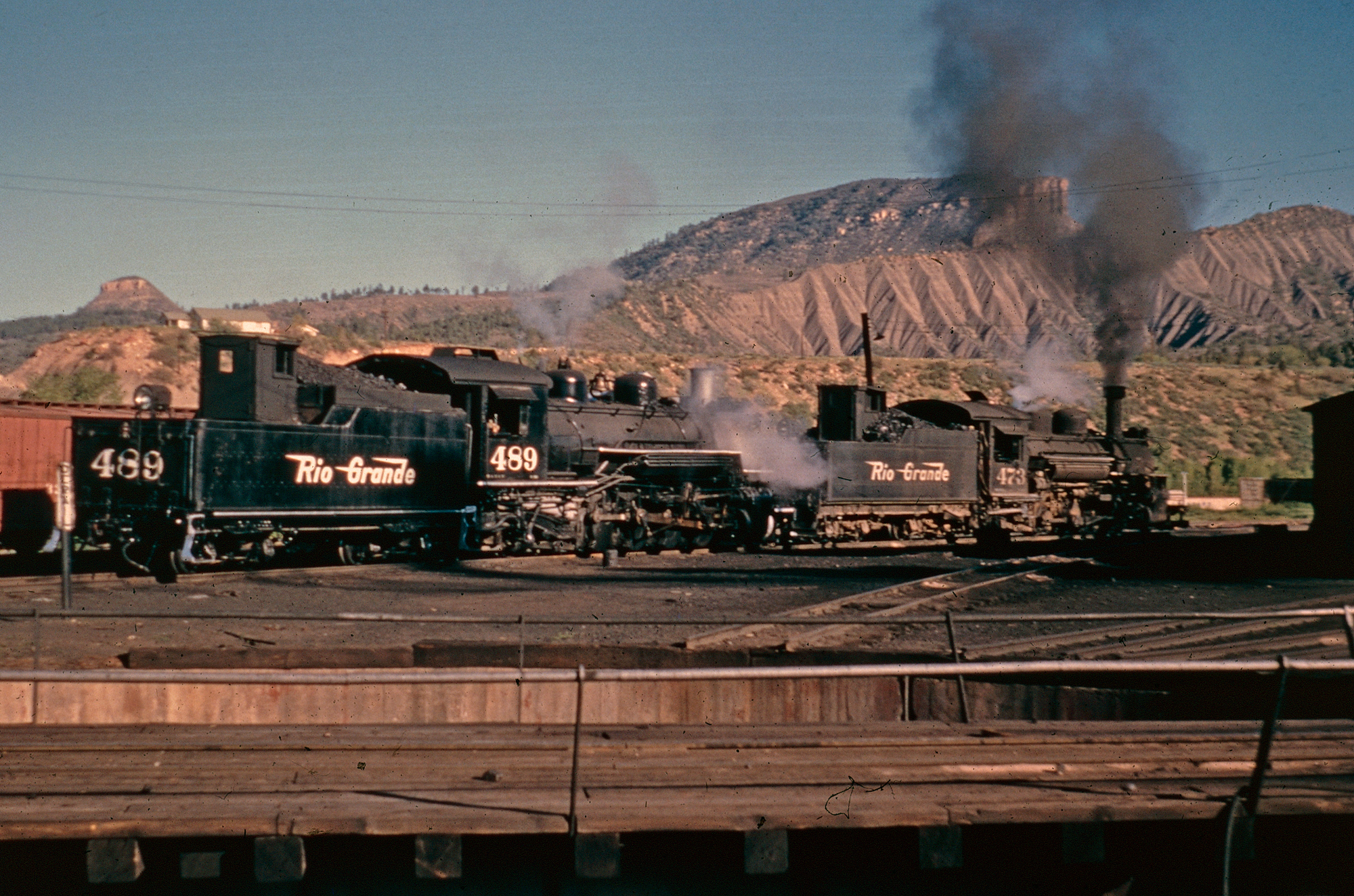 Rio Grande 2-8-2 #473 (K-28) and #489 (K-36) are ready for another day of work at the yard in Durango, Colorado on June 1, 1957. American-Rails.com collection.
Rio Grande 2-8-2 #473 (K-28) and #489 (K-36) are ready for another day of work at the yard in Durango, Colorado on June 1, 1957. American-Rails.com collection.Preservation
As Rio Grande's second-oldest fleet of 2-8-2s, the "Sport Models" were supplanted by newer Mikados as early as 1925 when the railroad picked up ten new K-36's from Baldwin, numbered 480-489.
These were the last new steamers the D&RGW purchased for its narrow-gauge system. A few years later, between 1928 and 1930 the railroad built ten new 2-8-2s for narrow-gauge use (from former 2-8-0s) and classified them as Class K-37's (numbered 490-499).
In 1981 the remaining three Class K-28's were acquired by the Durango & Silverton Narrow Gauge, which turned a section of the narrow-gauge operations around Durango, Colorado into one of the most popular tourist railroads in the country. Currently, #473 and #476 are operational while #478 is out of service.
Class K-36
The Rio Grande's last new order for narrow-gauge Mikados was its Class K-36's acquired during the mid-1920s. These 2-8-2s have often been considered the best on the system offering good power and a responsive throttle.
Along with the later K-37's nearly all survived until the D&RGW ended remaining steam operations at the end of the 1960s. Without doubt the K-36's are one of the best preserved class of Mikados from the railroad's fabled narrow-gauge operations.
Today, all but one of these locomotives survive and all are either in operation or on display at the Durango & Silverton Narrow Gauge and Cumbres & Toltec Scenic railroads, both excursion operations using remaining sections of the network in southern Colorado and northern New Mexico.
The K-36's and K-37's (manufactured by the Rio Grande's own shop forces) typified operations along the railroad's narrow-gauge territory. They were mainstay power on the San Juan District, providing sufficient power in a region dominated with stiff grades and sharp curves. In many ways, it is rather astounding this time capsule of railroading continued hosting freight trains until 1969!
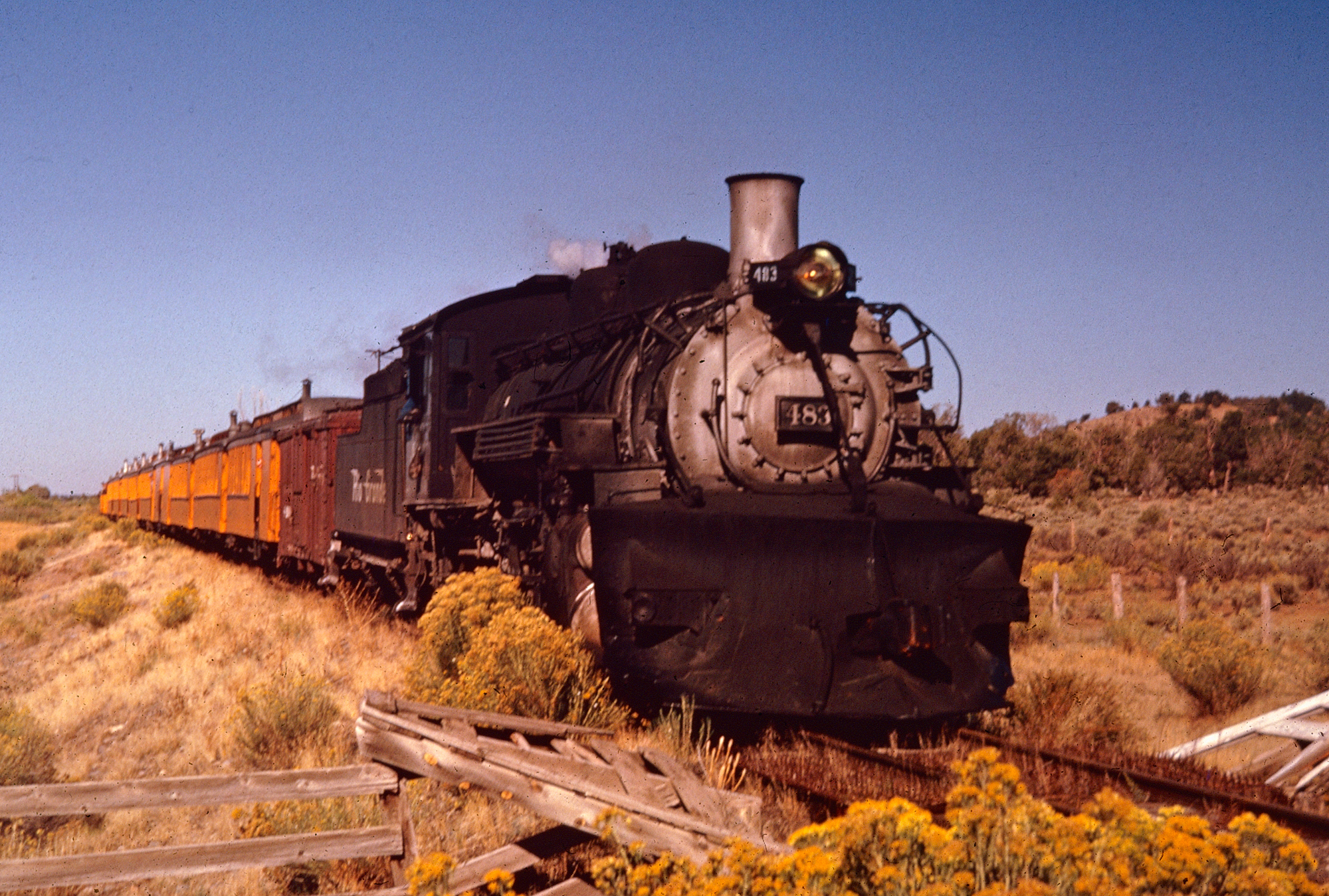 Rio Grande 2-8-2 #483 (K-36) leads a boxcar and empty passenger equipment westbound near rural Allison, Colorado on September 30, 1962. Author's collection.
Rio Grande 2-8-2 #483 (K-36) leads a boxcar and empty passenger equipment westbound near rural Allison, Colorado on September 30, 1962. Author's collection.By the 1920s the Denver & Rio Grande Western was amassing quite a roster of 2-8-2 Mikados, which eventually replaced much of the railroad's older fleet of 2-6-0s, 4-6-0s, and 2-8-0s that had been used since the 1870s.
Its first new Mikes were the Class K-27 "Mudhens" (the origin of its name has never been fully understood although a few stories persist) purchased from the Baldwin Locomotive Works in 1903. These locomotives were far more powerful than anything previously operated on the then Denver & Rio Grande's narrow-gauge network.
While the K-27's did have their problems, notably a loss of steam resulting from a shallow firebox, in general they operated relatively well and were well-liked by train crews.
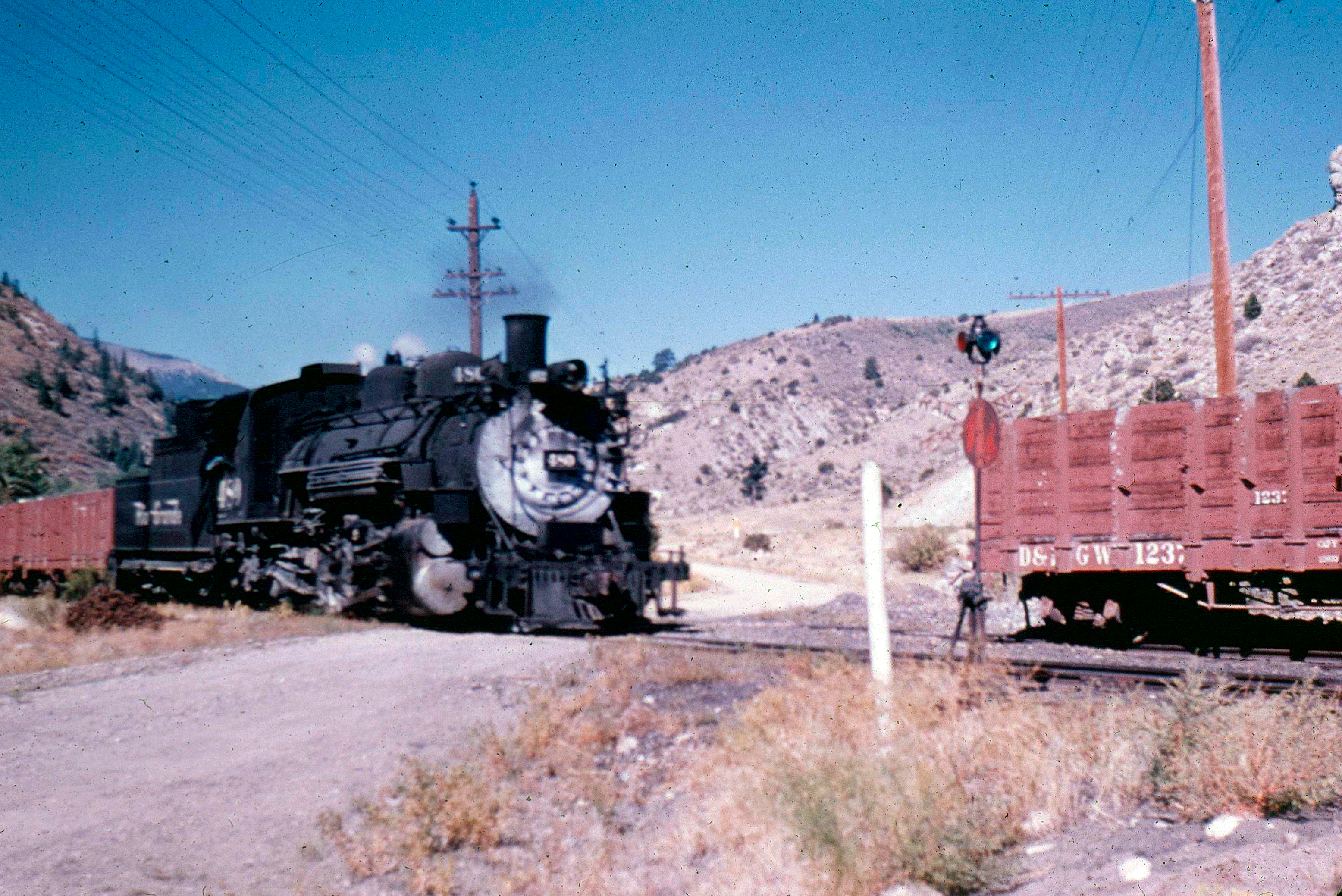 Rio Grande 2-8-2 #480 (K-36) switches empty gondolas, bound for Monarch, at Maysville, Colorado during the 1950's. Author's collection.
Rio Grande 2-8-2 #480 (K-36) switches empty gondolas, bound for Monarch, at Maysville, Colorado during the 1950's. Author's collection.It was another twenty years before the D&RGW acquired additional new 2-8-2s. During 1923 the American Locomotive Company delivered a batch of ten Class K-28's, numbered 470-479.
Officially, the steamers were meant to replace the remaining 4-6-0s in passenger service but they were also used in freight assignments as well. The "Sport Models," as they were also called, could operate at higher speeds with their taller drivers and corrected some of the flaws found on the K-27's while also offering a bit more overall power.
Interestingly, seven of the ten saw less than twenty years of service before being requisitioned by the U.S. Army during World War II for use in Alaska on the White Pass & Yukon Railroad.
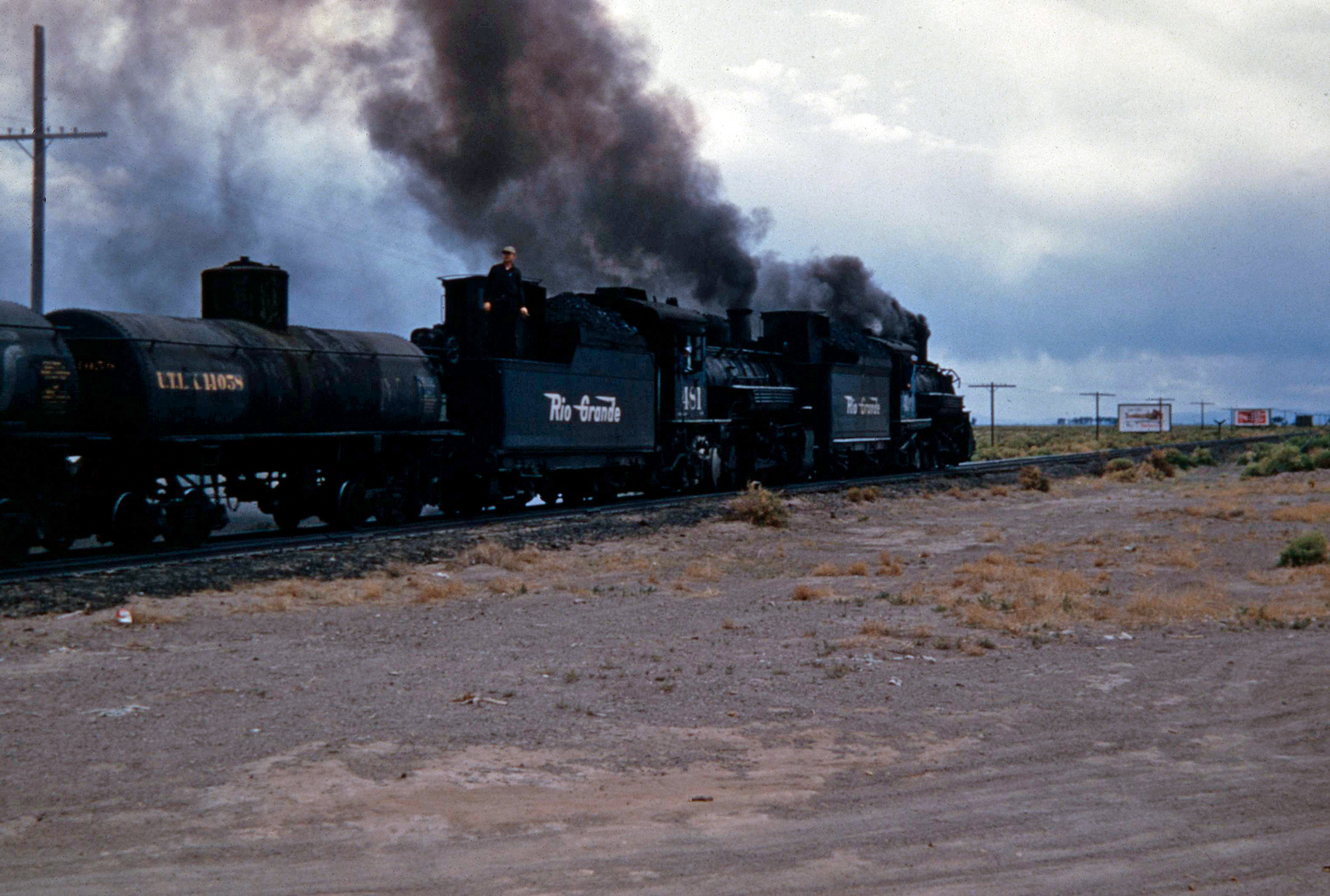 Rio Grande 2-8-2 #490 (K-37) and #481 (K-36) have a string of tank cars south of Alamosa Yard on June 18, 1956. American-Rails.com collection.
Rio Grande 2-8-2 #490 (K-37) and #481 (K-36) have a string of tank cars south of Alamosa Yard on June 18, 1956. American-Rails.com collection.During 1925 the Rio Grande purchased its final new batch of Mikados. Once again turning to Baldwin the railroad picked up ten more, listed as Class K-36 and numbered 480-489. Like the Mudhens these 2-8-2s featured outside frames where the driving wheels were located within the frame and counterweights and crankpins placed to the outside.
They were far more powerful than any narrow-gauge steamer operated on the Rio Grande at the time offering an axle loading exceeding 36,000 pounds and a tractive effort greater than 36,000 pounds (nearly 10,000 pounds more than the K-27's or K-28's). It is said that crews believed the K-36's to be the best Mikes on the network although they were noted for having a rather rough riding quality.
Roster
| Road Number | Builder | Model | Date Built | Disposition |
|---|---|---|---|---|
| 480 | Baldwin | Class K-36 | 1925 | To D&SNG, 1981 |
| 481 | Baldwin | Class K-36 | 1925 | To D&SNG, 1981 |
| 482 | Baldwin | Class K-36 | 1925 | To C&TS, 1970: To D&SNG, 1991 |
| 483 | Baldwin | Class K-36 | 1925 | To C&TS, 1970, On Display |
| 484 | Baldwin | Class K-36 | 1925 | To C&TS, 1970 |
| 485 | Baldwin | Class K-36 | 1925 | Fell into Salida, CO turntable pit in 1953, scrapped 1955. |
| 486 | Baldwin | Class K-36 | 1925 | To Royal Gorge Park, 1962: To D&SNG 1999 |
| 487 | Baldwin | Class K-36 | 1925 | To C&TS, 1970 |
| 488 | Baldwin | Class K-36 | 1925 | To C&TS, 1970 |
| 489 | Baldwin | Class K-36 | 1925 | Retired 1962: To C&TS, 1970 |
Three years later in 1928 the D&RGW rounded out its fleet of Mikados with another batch of ten, this time home-built its own shops using left over standard-gauged boilers from its older Class 190 2-8-0s.
These locomotives were listed as Class K-37 and are regarded as the most powerful Mikes the railroad operated. While the earlier K-27's and K-28's were stored or scrapped after the 1950s most of the K-36's and K-37's remained in service until the Rio Grande abandoned much of its narrow-gauge network after 1970.
Incredibly, nearly every example of both classes are preserved today thanks to the forward thinking and generosity of the railroad, which donated the locomotives and the remaining trackage in southern Colorado and New Mexico for preservation.
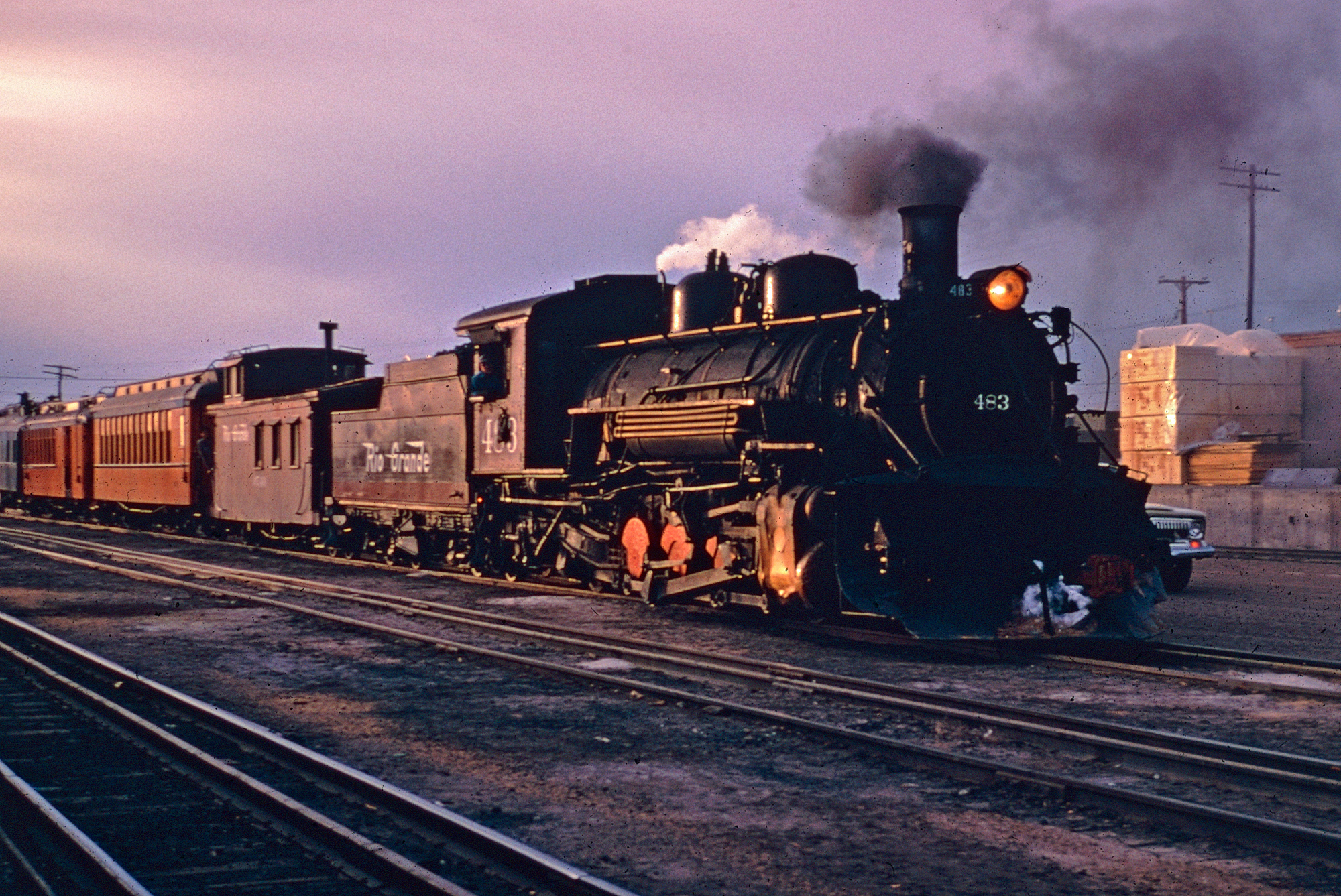 Rio Grande 2-8-2 #483 (K-36) steams into Alamosa, Colorado with a railfan special on the evening of November 24, 1968. Author's collection.
Rio Grande 2-8-2 #483 (K-36) steams into Alamosa, Colorado with a railfan special on the evening of November 24, 1968. Author's collection.Today, four Class K-36's are in service on the Durango & Silverton Narrow Gauge (numbers 480, 481, 482, and 486) while five others are at the nearby Cumbres & Toltec Scenic, four of these are operational (numbers 484, 487, 488, and 489) while #483 has been on display in Chama, New Mexico since the 1970s.
Only one, #485, was not preserved; the locomotive was heavily damaged following an incident in 1953 and was scrapped by the Rio Grand a few years later in 1955. Finally, if you would like to ride behind these locomotives you can do so on either the Durango & Silverton or Cumbres & Toltec Scenic tourist railroads.
Class K-37
Rio Grande K-37's represented the last, and newest, of its fabled fleet of narrow-gauge Mikados. However, unlike earlier classes these 2-8-2s were not purchased new, the D&RGW home-built them from former 2-8-0 Consolidations during the late 1920s.
This project was somewhat unique in that the railroad took former standard-gauged locomotives and overhauled them for narrow-gauge service. The idea proved successful as this last batch was the most powerful among the four classes.
The K-37's remained in service throughout the 1960s before the Rio Grande donated most to either the upstart Durango & Silverton Narrow Gauge or the Cumbres & Toltec Scenic where many can still be found preserved although all are not operational.
The Mikado became a common sight along Rio Grande's fabled San Juan District during its four decades.
The spunky little steamers offered needed traction to tackle the stiff grades of 10,015 foot Cumbres Pass while also maintaining a short wheelbase to handle the needed curvature.
Because the K-36's and K-37's were still running at the time Rio Grande donated much of the San Juan District most were preserved.
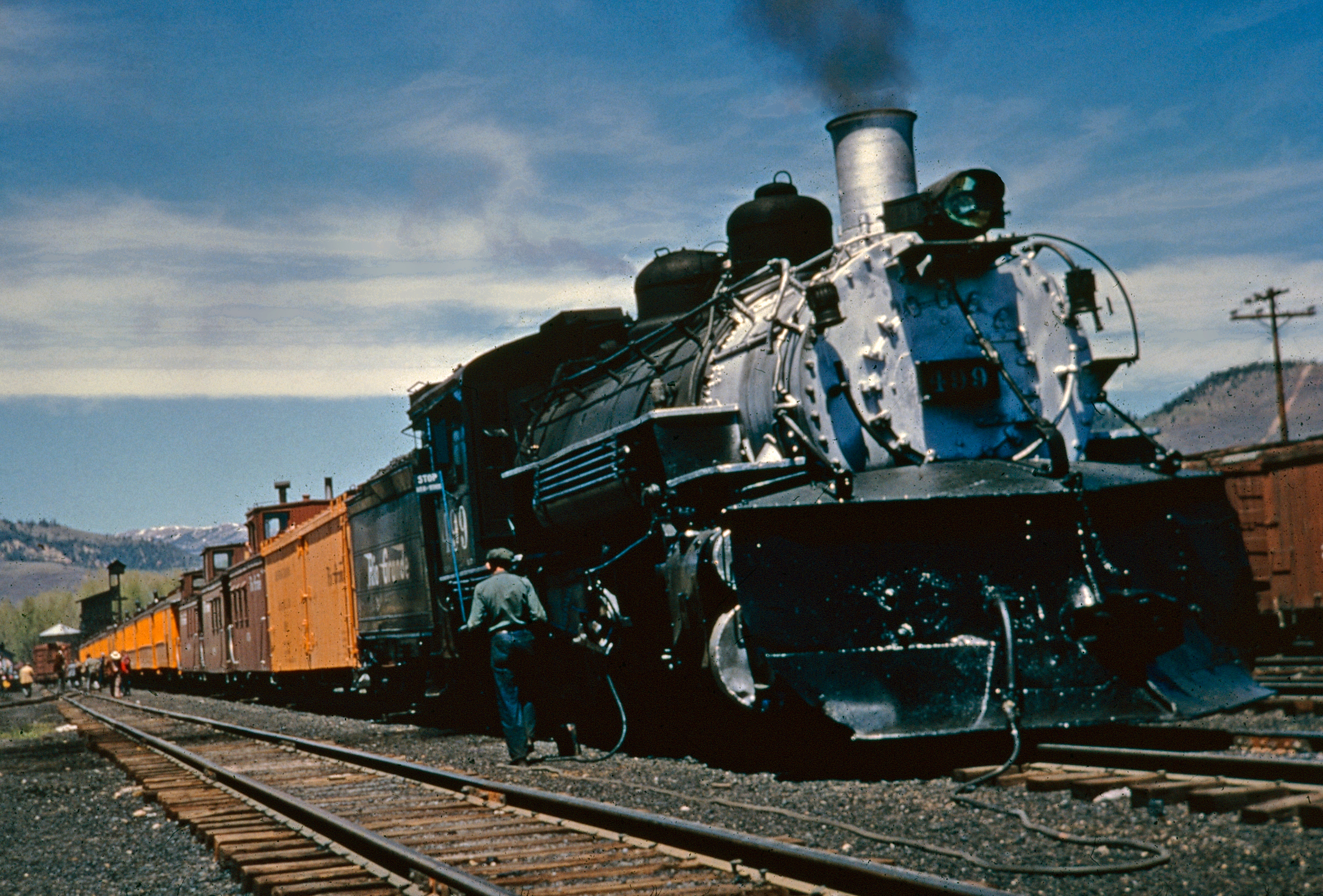 Rio Grande 2-8-2 #499 (K-37) has a passenger special readying to leave Chama, New Mexico in May, 1955. Author's collection.
Rio Grande 2-8-2 #499 (K-37) has a passenger special readying to leave Chama, New Mexico in May, 1955. Author's collection.During the late 1920s the Rio Grande decided that it needed additional, and more powerful 2-8-2s to complement its fleet of aging Class K-27 "Mudhens" along with its newer Class K-28's and K-36's that had arrived earlier that decade.
All three classes had been purchased new for narrow-gauge service, either from the Baldwin Locomotive Works (K-27's and K-36's) or the American Locomotive Company (K-28's). In a rather interesting move, the D&RGW took it upon itself to build its own instead of buying more new steamers in an effort to reduce costs.
In 1928 the railroad took ten of its former Class C-41 2-8-0 Consolidations (built in 1902 by Baldwin originally as Class 190 and later rebuilt in 1924) and used their boilers to construct ten "new" narrow-gauge 2-8-2s.
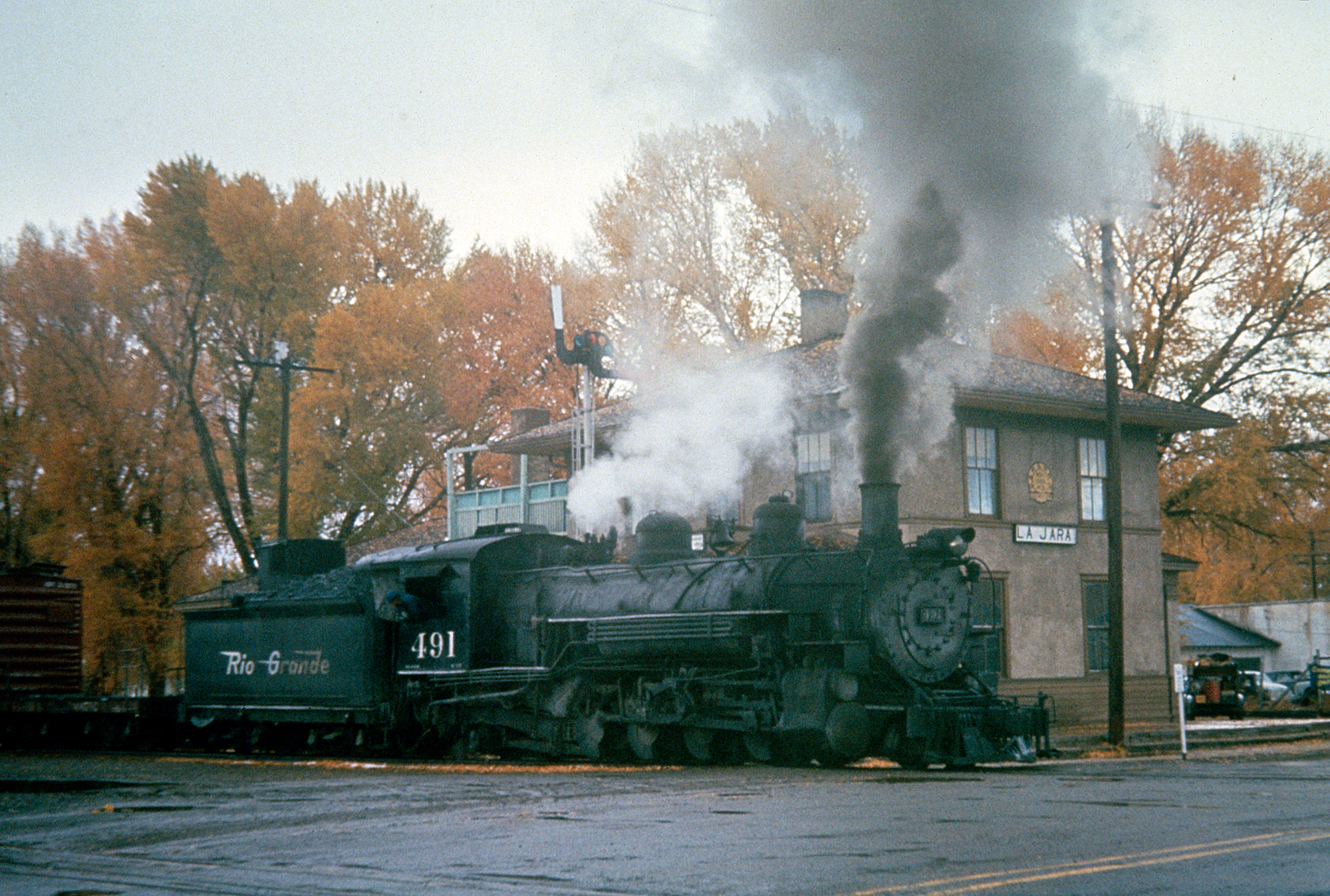 Rio Grande 2-8-2 #491 (K-37) carries out switching chores in front of the depot at La Jara, Colorado during a rainy and wet fall day in the 1960s. American-Rails.com collection.
Rio Grande 2-8-2 #491 (K-37) carries out switching chores in front of the depot at La Jara, Colorado during a rainy and wet fall day in the 1960s. American-Rails.com collection.The C-41's used included numbers 1003, 1004, 1005, 1009, 1014, 1020, 1021, 1023, 1025, and 1026. While the boilers were reused Baldwin supplied new 2-8-2 frames and wheels for the work, which was done inside the Rio Grande's Burnham Shops located in Denver.
The new Class K-37's looked a little small for their over-sized boilers and actually featured a wheelbase a few feet shorter than the K-36's.
Despite how they may have appeared the new Mikados were the most powerful narrow-gauge steam locomotives ever operated on the D&RGW offering axle loadings of nearly 40,000 pounds and a tractive effort of more than 37,000 pounds.
This class was also the heaviest weighing more than 153 1/2 tons (or nearly 20 tons heavier than the nearest Class, the K-28's).
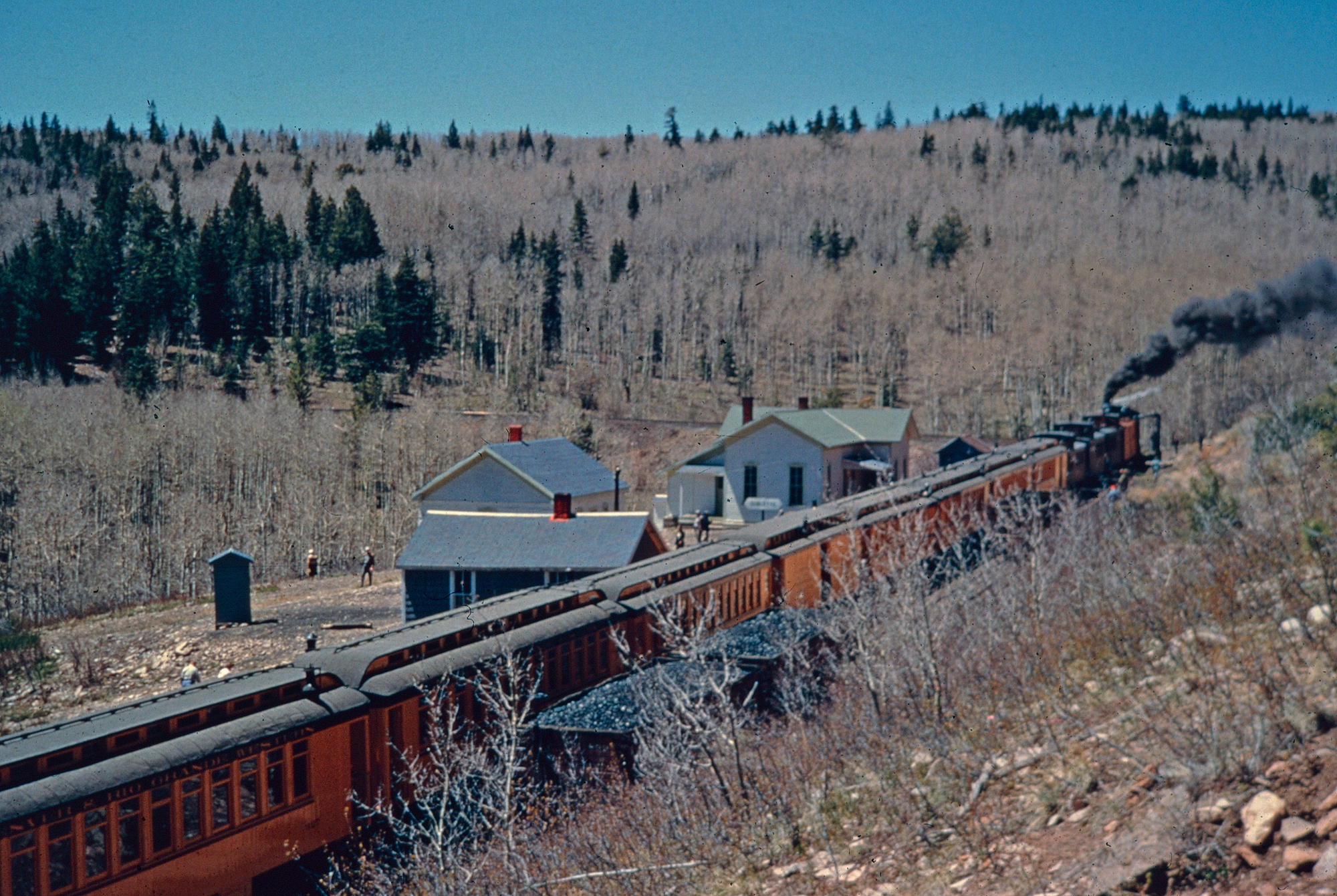 Although not visible, Rio Grande 2-8-2 #499 (K-37) is at the head-end of this westbound passenger train taking on water at rural Sublette, New Mexico in May, 1955. Author's collection.
Although not visible, Rio Grande 2-8-2 #499 (K-37) is at the head-end of this westbound passenger train taking on water at rural Sublette, New Mexico in May, 1955. Author's collection.If there were any notable issues or problems with these Mikes in service, such as a poor riding quality or running issues, it is not known.
The K-37's could most often, at least during their heyday years, be found tackling the stiff grades and tight curves of the Monarch Branch hauling various types of minerals, aggregates, and other freight traffic.
This secondary narrow-gauge line was well-noted for its particularly steep grades and was not part of the more well known system west of Alamosa, Colorado.
Instead, the branch left the Rio Grande regular, standard-gauged main line at Salida, Colorado and reached Monarch not far away to the northwest.
Grades along the route reached as steep as 4.5% and included a double switch-back to scale the 10,000 feet in elevation needed to reach the Colorado Fuel & Iron Company's (a one-time major steel producer) limestone quarry in Monarch.
Roster
| Road Number | Builder | Model | Date Built | Disposition |
|---|---|---|---|---|
| 490 | D&RGW | Class K-37 | 1928 | Rebuilt From Class C-41 #1014: Retired 1962, Dismantled 1964 |
| 491 | D&RGW | Class K-37 | 1928 | Rebuilt From Class C-41 #1026: To Colorado Historical Society 1970: On loan to Colorado Railroad Museum |
| 492 | D&RGW | Class K-37 | 1928 | Rebuilt From Class C-41 #1021: To C&TS 1970, On Display In Chama |
| 493 | D&RGW | Class K-37 | 1928 | Rebuilt From Class C-41 #1005: To D&SNG 1981, On Display In Silverton |
| 494 | D&RGW | Class K-37 | 1928 | Rebuilt From Class C-41 #1020: To C&TS 1970, On Display In Antonito |
| 495 | D&RGW | Class K-37 | 1928 | Rebuilt From Class C-41 #1004: To C&TS 1970, On Display In Antonito |
| 496 | D&RGW | Class K-37 | 1930 | Rebuilt From Class C-41 #1023: Scrapped, 1955 |
| 497 | D&RGW | Class K-37 | 1930 | Rebuilt From Class C-41 #1003: To D&SNG, 1981: Stored Serviceable |
| 498 | D&RGW | Class K-37 | 1930 | Rebuilt From Class C-41 #1009: To D&SNG, 1981: On Display In Durango |
| 499 | D&RGW | Class K-37 | 1930 | Rebuilt From Class C-41 #1025: To D&SNG, 1981: To Royal Gorge Park, 1999 |
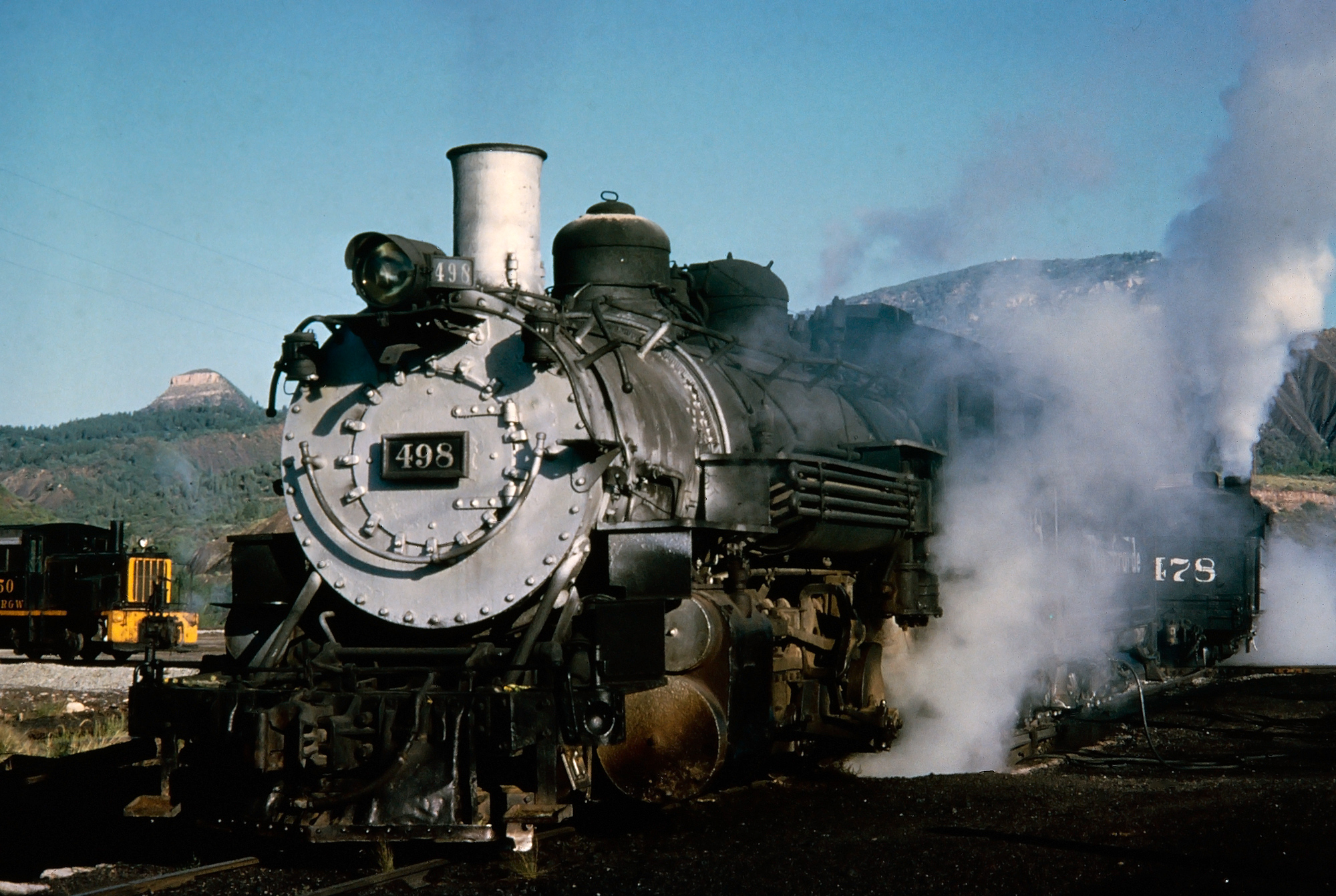 Rio Grande 2-8-2 #498 (K-37) readies to leave Durango, Colorado with an eastbound freight in the summer of 1968. American-Rails.com collection.
Rio Grande 2-8-2 #498 (K-37) readies to leave Durango, Colorado with an eastbound freight in the summer of 1968. American-Rails.com collection.As the Rio Grande began scaling back its narrow-gauge network in the 1950s it switched the branch (which had originally been built to serve the booming silver, lead, and iron ore industries until the Silver Panic of 1893 ended most mining activities at the time) to standard-gauge in 1956 and moved the Class K-37's to the remaining network west of Alamosa.
As for the Monarch Branch, four axle GP9s, GP35s, GP30s, and GP40s took over as primary power (six-axle units could not handle the tight curves). After the quarry closed in the early 1980s the branch was abandoned.
Once they headed south most of the Class K-37's carried on in regular service until the D&RGW began abandoning its remaining narrow-gauge system during the late 1960s.
In another nod towards history, just as it had done with the K-36's the Rio Grande donated its remaining fleet of K-37 Mikados to either the Durango & Silverton, Cumbres & Toltec Scenic, or a state preservation society between 1970 and 1981.
Today, currently all remaining eight Mikes are on public display and not operational, except for #497 which is stored serviceable on the D&SNG.
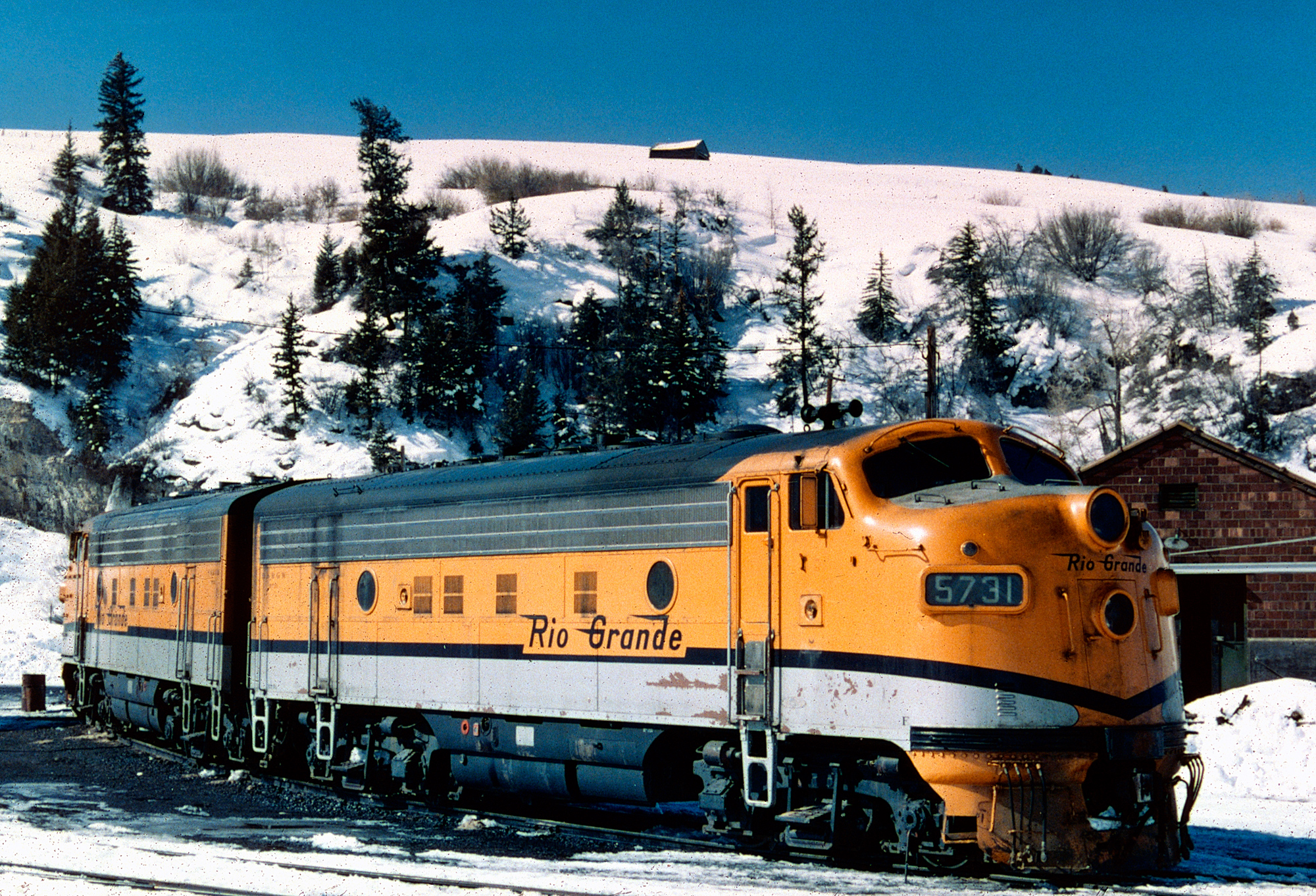 Rio Grande F7A's #5731 and #5721 layover at Minturn, Colorado on March 2, 1968. Ed Fulcomer photo. American-Rails.com collection.
Rio Grande F7A's #5731 and #5721 layover at Minturn, Colorado on March 2, 1968. Ed Fulcomer photo. American-Rails.com collection.Despite the rugged topography the Rio Grande possessed an impressive operation cutting through the heat of the Rockies.
The road was true to its slogan, "Through The Rockies, Not Around Them" as it boasted three main lines across the region; over Moffat Tunnel, through the Pueblo gateway crossing Tennessee Pass, and the original main line to Grand Junction via Salida/Montrose.
- It nearly opened a fourth route from Antonito to Montrose, via Durango but topography between the rail-heads at Ouray and Silverton [only 23 miles apart] proved too rugged to support a manageable alignment. -
The company financially improved throughout the 1930's, particularly during World War II's traffic blitzkrieg. It was finally reorganized on April 11, 1947 carrying the same as before but permanently separated from the Missouri Pacific and Western Pacific.
Afterwards, it enjoyed several decades of prosperity. In 1949 it launched one the best remembered streamliners of all time, the California Zephyr, in conjunction with the WP and Chicago, Burlington & Quincy.
Southern Pacific Purchase
After its cancellation in 1970 the Rio Grande continued to host the service as the Rio Grande Zephyr from Denver to Salt Lake City.
This lasted until 1983 when it finally turned its equipment over to Amtrak. After purchasing an ailing Southern Pacific in 1988, Rio Grande Industries (Rio Grande's parent company) slowly integrated the smaller Denver & Rio Grande Western into the much larger SP.
By the time Union Pacific purchased Southern Pacific in 1996 the D&RGW had largely disappeared. Today, its Denver - Salt Lake City main line remains an important component under Union Pacific while several other segments, like those described, are popular tourist attractions.
Public Timetables (March, 1940)
Recent Articles
-
Oklahoma Short Line Railroads: A Complete Guide
Apr 03, 25 12:04 PM
This article highlights the short line railroads operating within the state of Oklahoma. -
New Mexico Short Line Railroads: A Complete Guide
Apr 03, 25 11:42 AM
This article briefly highlights the Class III short line railroads operating within the state of New Mexico. -
North Carolina Short Line Railroads: A Complete Guide
Apr 03, 25 11:30 AM
This guide highlights all of the short line railroads currently active in the state of North Carolina.
